** denotes a direct ancestor of mine in this text. Unless indicated, all photographs by Sally-Ann Clur, Copyright: © saclur
8th November – First steps: Cape Town to Wilderness
Not long after arriving in Cape Town, I took off my shoes and walked on the lawn, marveling at the texture of grass blades tickling my naked feet. My feet succumbed to warm comfort as I stepped onto the tiles, and I felt the sun soak through my skin. “Aah,” I heard in the distance, “you are home again, bare foot like a South African”. It was Linety who maintained the enchanting atmosphere of my sister Belinda Louise Clur’s house. This made me smile. When my eldest son, Sean, was about 8 years old, we sometimes skinny dipped in the cool pool and then baked on the surrounding slasto in the summer sun in the privacy of Belinda’s vast garden. Coming from Europe the idea of walking bare foot was rather foreign to Sean. He called it “Skinny Footing” which prompted Belinda to write a song called “Skinny Footing in Africa” that she played on her guitar for him.
Against the background of an ongoing war in the Ukraine and the possible repercussions on world peace following the re-election of President Donald Trump, we set off from Cape Town on another trip to the Eastern Cape. During our visit to The Amathole Museum in March this year, it was suggested that more genealogical information about my father’s family and the German settlers of 1857/8 may be found in the East London Museum. (See Eastern Cape Nostalgia) So, this time East London, or Buffalo as it is now called, was our ultimate destination. The intrepid traveling trio consisted once again of myself, Wilfried Visser (my partner), and my 91-year-old mother, **Denise Clur, née Barker.
We set off in an easterly direction, as before, and followed the N2 through Somerset West. We passed grey-green mountains skirted by pine forests to the left and the ocean on the right. Yellow hills patterned with neat, engraved lines from the recent harvesting filled the horizon. They were interspersed by surprisingly green uncultivated areas with thorny scrabble, here and there a simple farmhouse or a large farmstead with old Dutch gables and a line of eucalyptus or wattle trees. The occasional guineafowl pecked at the side of the road. We stopped first at our traditional pitstop Tredici in Swellendam, (meaning a baker’s dozen, or 13), and enjoyed a cup of coffee and savoury turnover pastries. Then we flippantly indulged in trying on every hat in the shop. We did, however eventually buy three of them! The birds were still flying around inside and resting on the chandeliers.



Copyright: © saclur
Our first night was spent in Wilderness. The roadworks between George and Wilderness were still ongoing. Descending towards the coast the natural vegetation was thick and wild with the creepers linking tree tops shining in the sun after the recent drizzle. Access to our B&B was difficult, with a steep decline from the road to the parking area, necessitating entering in reverse, expertly executed by Wilfried, to expediate the exit later. The view of the ocean and the expanse of sand beach from the room and veranda was spectacular, making the inconvenience of the parking worthwhile. We took the steps down to the beach below and came across a group of young locals puffing on a shisha pipe at the bottom of the stairs. Around them their discarded rubbish, used plastic bottles, cartons and aluminium foil, was scattered. It was a surreal sight marring the natural beauty we were within. The tide was coming in and very cold, making us yell as it splashed over our toes, feet and ankles and swelled upwards soaking my shorts.
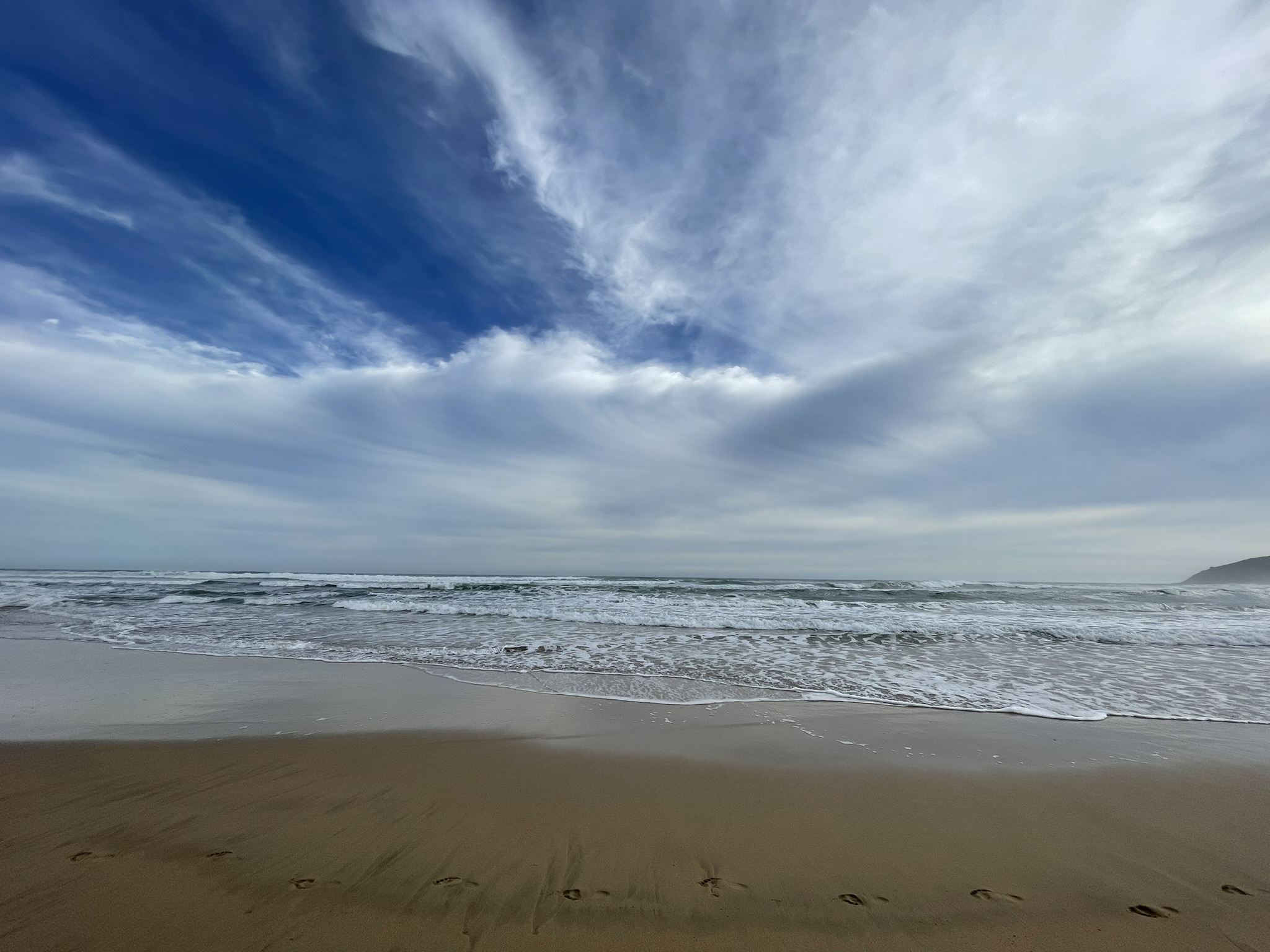
Back in Amsterdam, Ajax was playing Maccabi Tel Aviv while we were eating supper at a local LGTB..xyz+ friendly restaurant. After Ajax won 5:0 unrest broke out and several Maccabi supporters were assaulted. Many arrests followed, and a special plane was sent from Israel to pick up the Maccabi fans. Accusations of provocation from one side and deliberate victim hunting from the other, as well as apathy and favouritism on the side of the authorities filled reports in the international news and social media. The event evoked emotional discussions amongst us about the state of the world and the present threats to world peace, which ruined what should have been a lovely evening eating peri-peri prawns in the open air.
9th November – Wilderness to Colchester
My mother is suffering from optic atrophy and struggles to see. She manages to just follow Netflix series with spoken audio texts and with the TV very close to her. Wilfried thought she would benefit from an audiobook subscription which he organized for her at breakfast the next morning. Once we were on the road again, “1984” echoed through the car. After the heavy discussions the night before, Georg Orwell’s prediction of 1984 with Big Brother watching you, the Ministries of Truth, Peace, Love and Plenty hypocritically spreading lies, defining the past, maintaining war, torturing and starving people and restricting personal freedom and individualism, was almost too much for me.
We travelled further along the N2 through Gqeberha, (formerly Port Elizabeth), with dolosse lining and protecting the coastline. Dolosse were designed by a South African, Aubrey Kruger. The name ‘dolos’ apparently comes from an observation his father made that they looked like the similarly named ox knuckle-joint bones used by Sangomas, (South African traditional healers).
Just beyond Gqeberha, we stopped at the Elephant Footprint Lodge in Colchester just near the Addo Elephant Park. As we approached, the proximity of the “safari” lodge to domestic houses made me doubt its authenticity. However, the layout of the rooms around a central area with a small pool, like a boma or elephant’s foot, soon made one forget the nearby suburbia. The rooms were vast, thatched with high wooden rafters and wooden furniture. African cloths and sculptures decorated the walls, and the lamps were made of wire and beads. The bath was large, oval and inviting. Wilfried and I could both fit into it, the water was hot and relaxing. In the evening, we had dinner “safari lodge” style in front of a wood fire while The Lion Sleeps Tonight and Pennywhistle by Claire Johnston and Mango Groove, the Click Song by Miriam Makeba, and Asimbonanga by Jonny Clegg – The White Zulu and Savuka played in the background. The South African ambiance complemented the meal of biltong soup, warthog stew and red peppers stuffed with kudu. I felt a bit like a tourist in my own country.
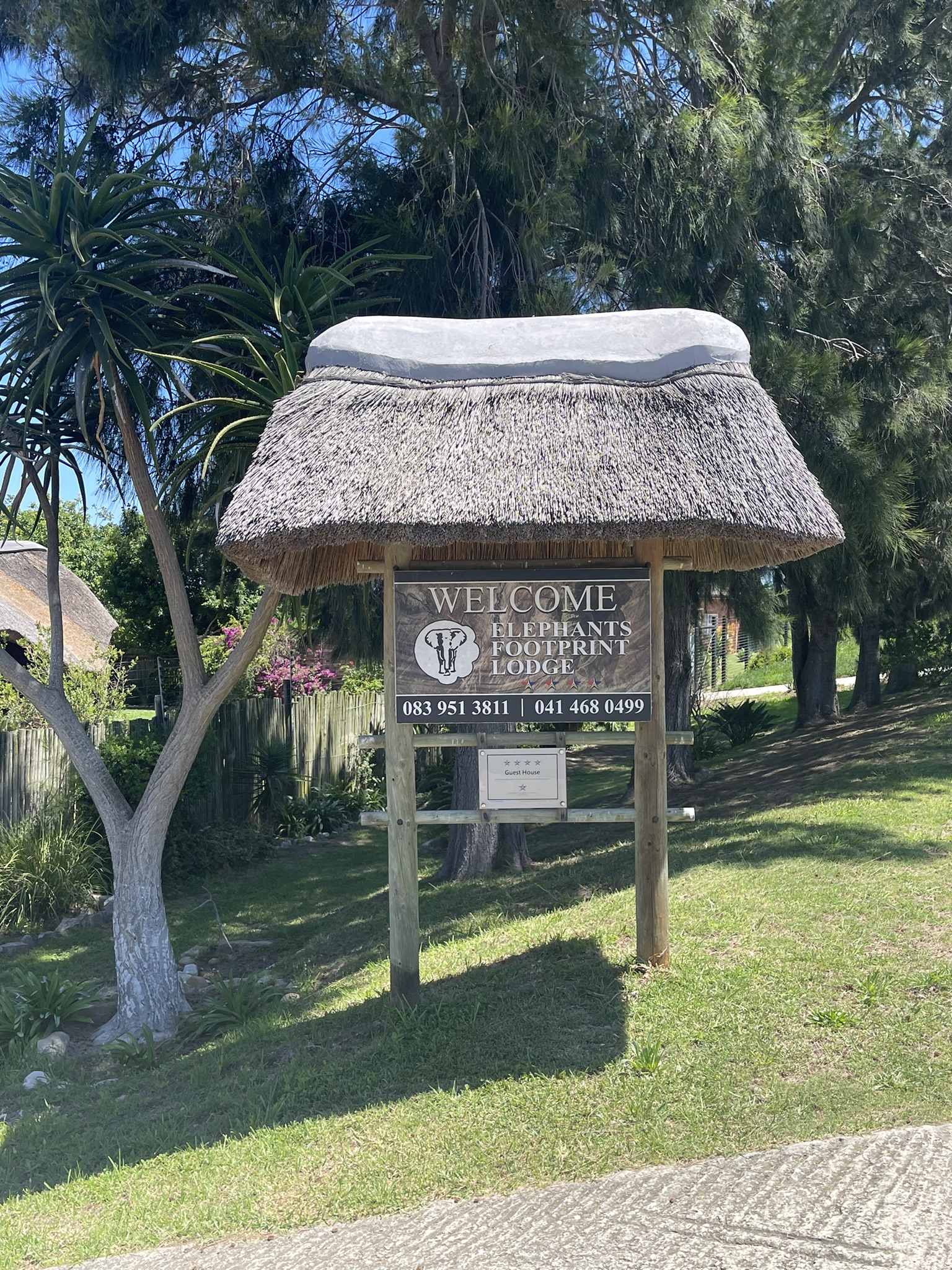
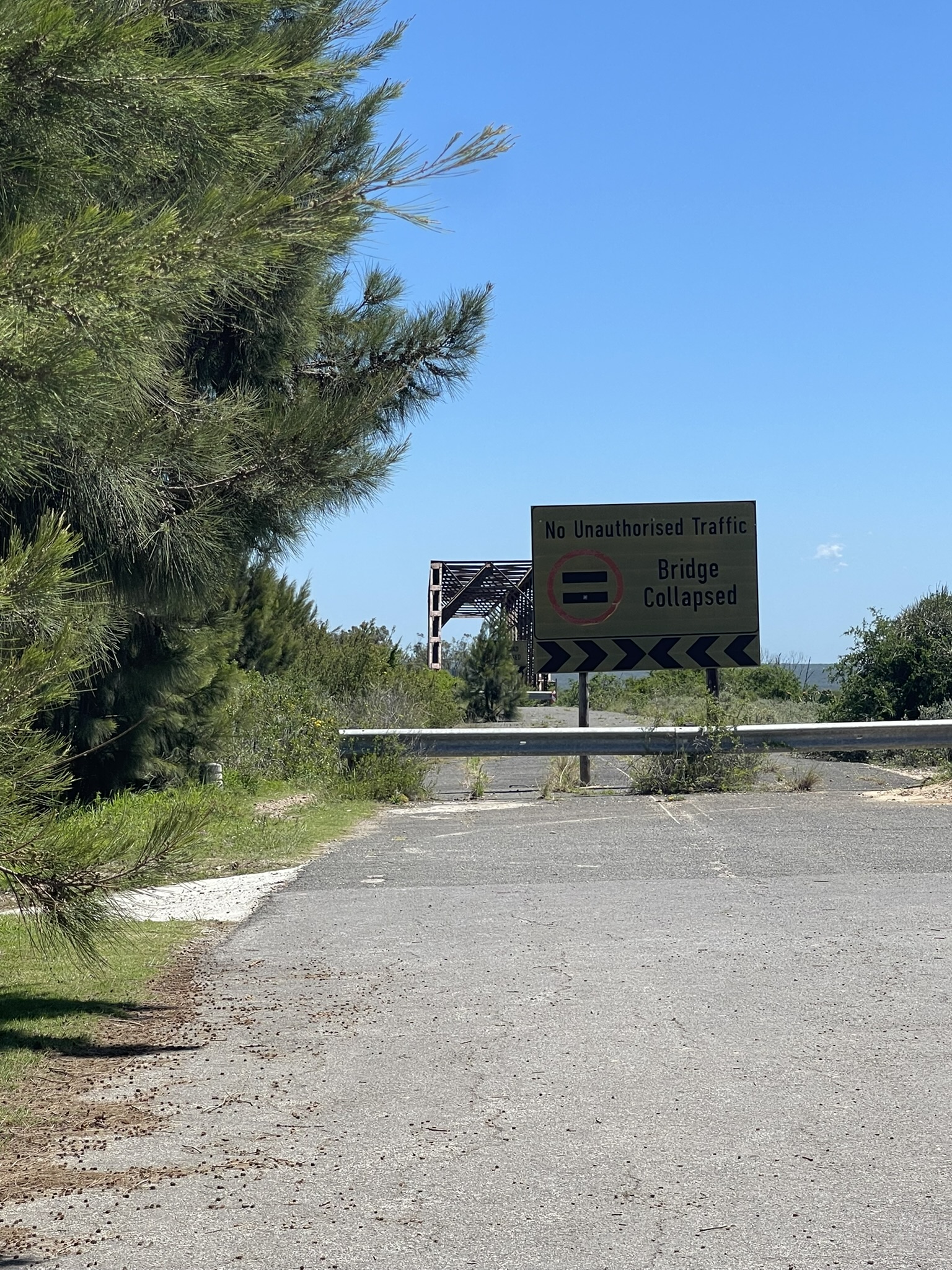
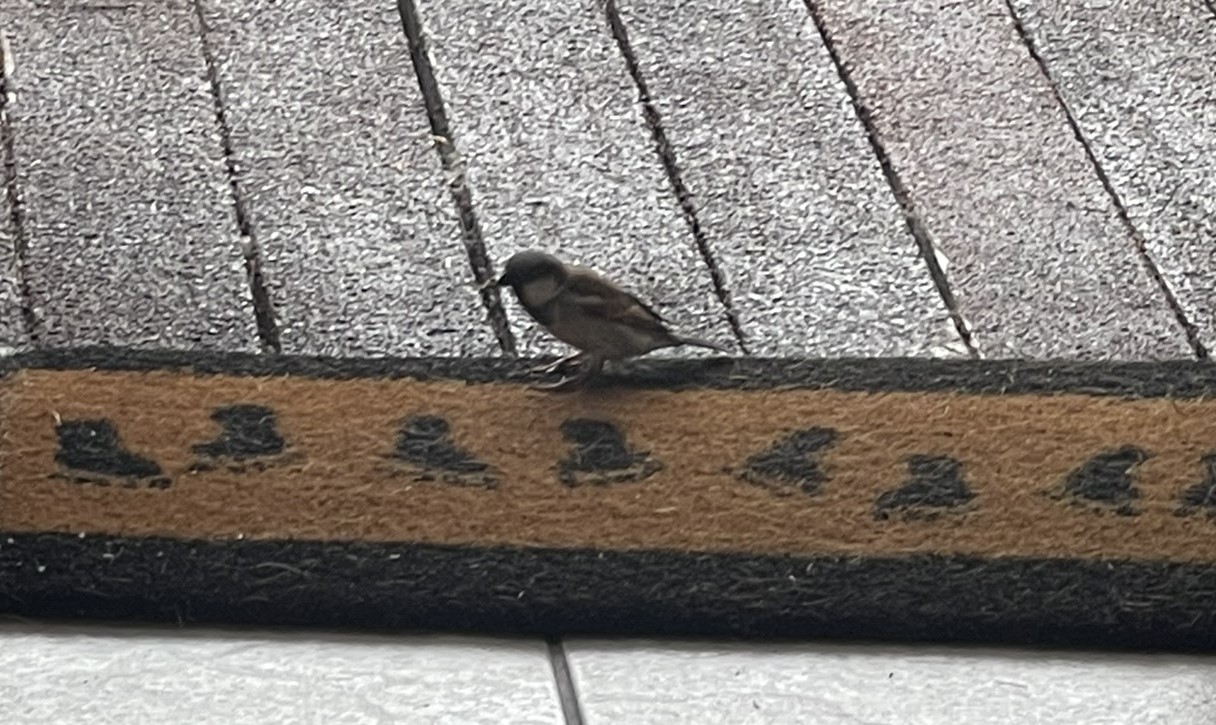
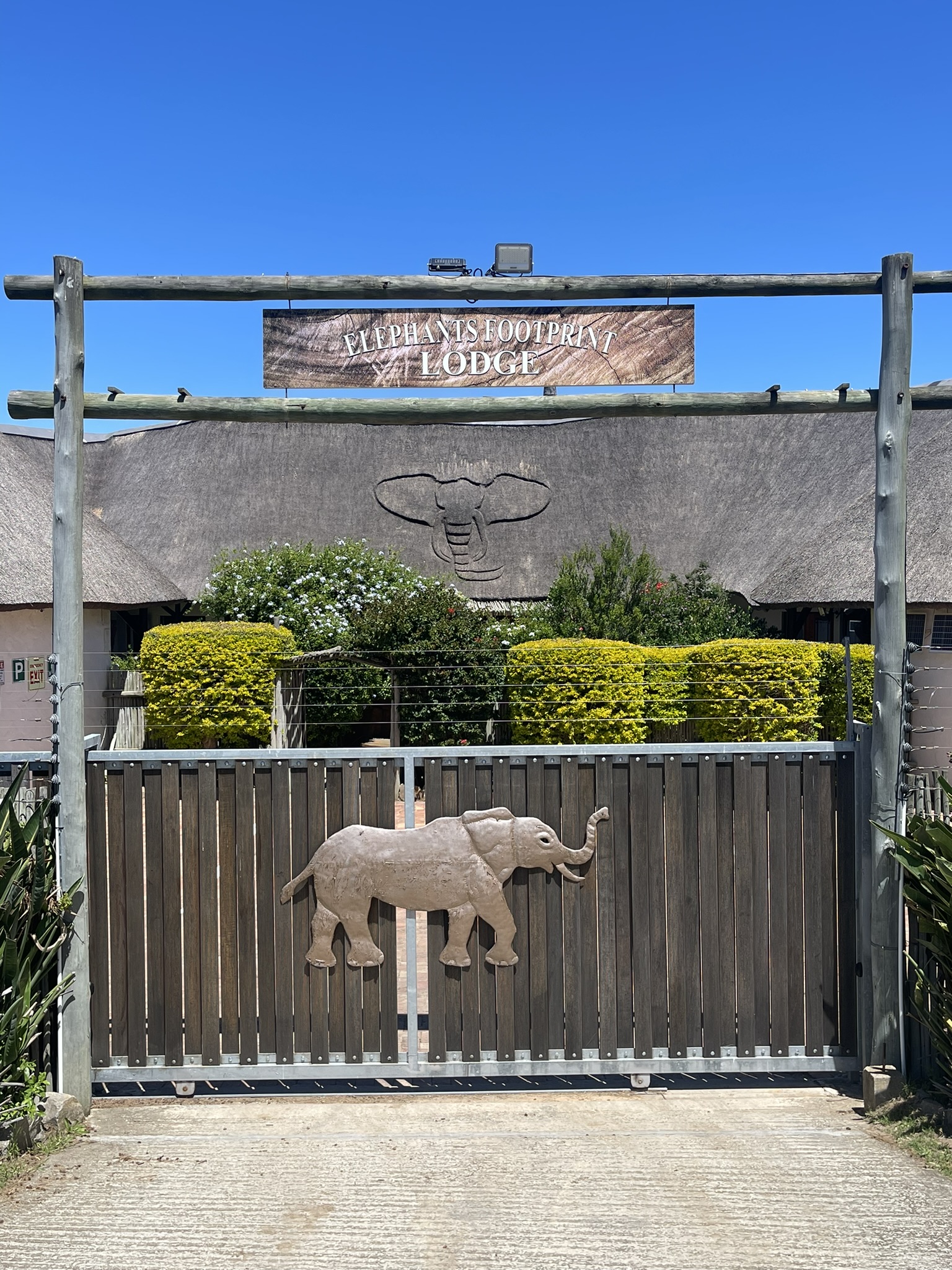
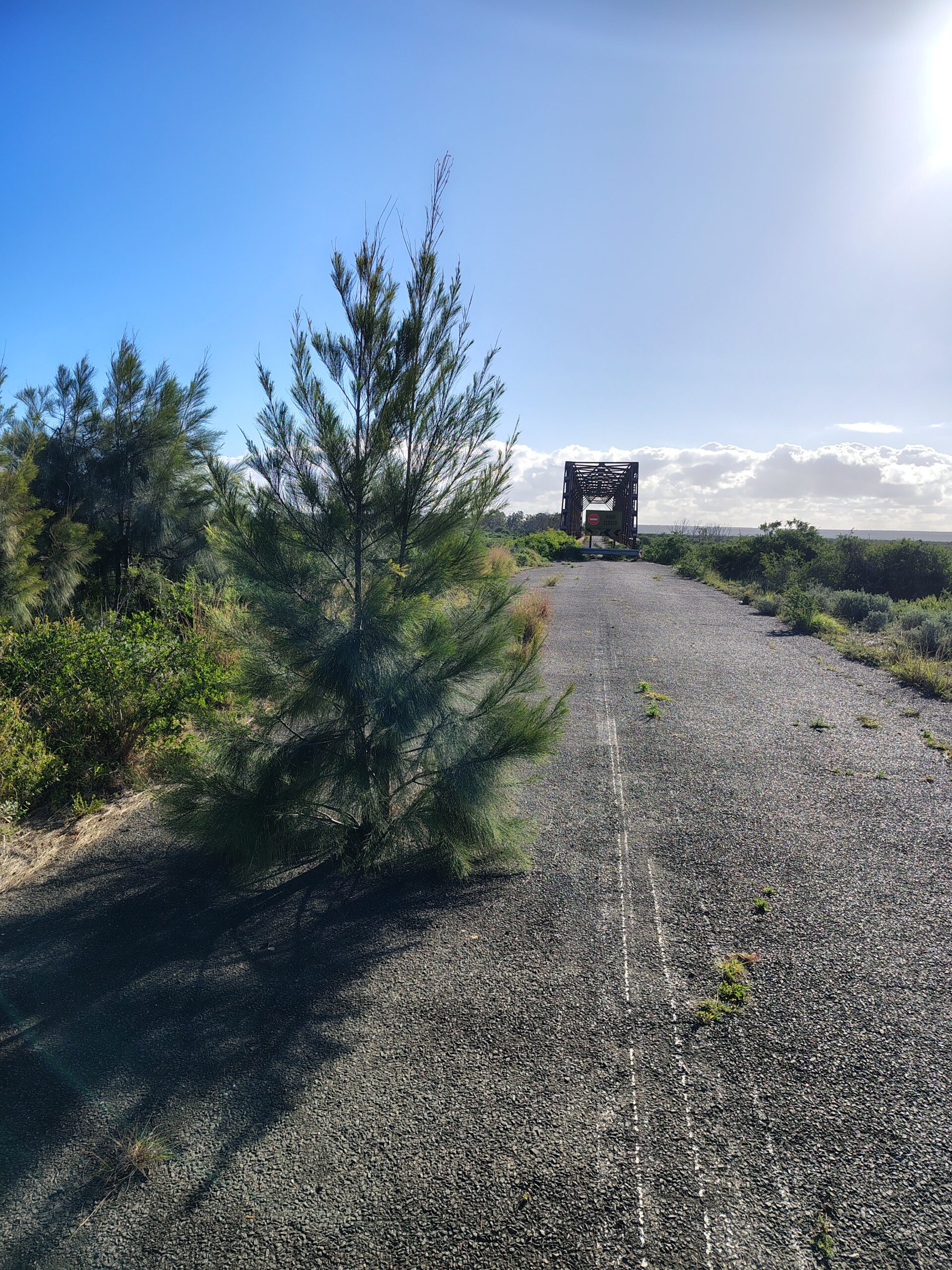
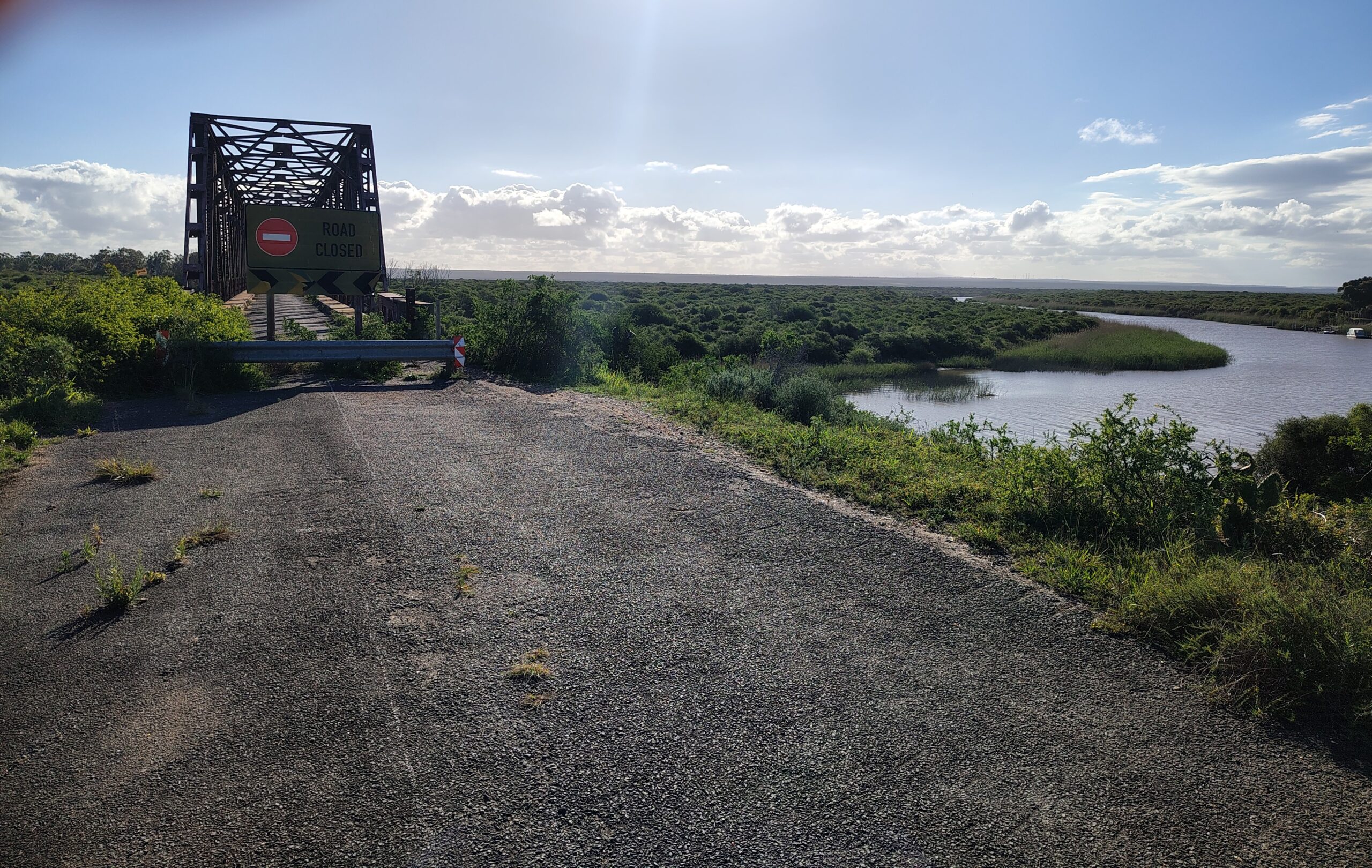
A short distance from the entrance the road was closed, just before an old iron-bridge had subsided into the valley. In the middle of the old asphalt a pine tree was growing. Nature was repossessing this bit of human expansion. As I walked on the prickly hot gravel at the edge of the road with my bare feet, a family of vervet monkeys looked down from some nearby trees. In the morning while we ate breakfast a small bird ventured inside the dinning room looking for fallen scraps. It was quite skittish and frequently returned to the threshold where it waited on the doormat covered in dark footprints for its next opportunity.
10th – 11th November – East London
On the road again we soon left the N2 and took the R72 in the direction of the coast, heading towards East London. Just before the toll road we made a detour and followed the winding route south to Nature’s Valley enjoying the beautiful scenery, before proceeding back to the toll road. When finally on the toll road I needed to pee. Finding a suitable place to stop was difficult and eventually I was forced to crouch at the roadside. I got out of the car, stubbing my left big toe on the hot tarmac, lifting off a large flap of skin as I went. A call, “only weewee,” echoed out of the car as I searched for a relatively discrete location to relieve myself. “Only weewee” is a command that developed when letting my black and tan Jack Russel out in my small garden in the early morning. I laughed, increasing my urgency as I did, and was forced to crouch where I was. The road had been rather quiet, but now several approaching cars and trucks suddenly appeared from both sides. I had to be quick, and before I knew it my ankles were being sprinkled with warm wetness in my haste. I felt rather stupid later as I dabbed the blood off my injured toe and dried my ankles in the car.
I don’t know if I have ever been to East London before, so I did not have any real expectations, but nonetheless I was disappointed. The roads were in a bad state. Avoiding the abundant and large potholes while driving was quite a task. My mother told me that when they lived in East London as a young girl, they used to swim at Nahoon beach every Sunday. Her father, **William Edward Barker used his trident spear to catch sole in the sand at the beach. At first, we looked for a B&B in that area, but later learnt that the other side of the Nahoon River was a safer option. We settled for the Reef B&B with an ocean view from the breakfast area. There was a miscommunication, and the owner had not been expecting us. When we arrived, we were greeted by a closed electric gate and could not get in. While waiting at the gate, other guests, with a gate remote arrived. They were Dutch. Despite several attempts, we failed to convince them to open the gate for us. They had been told not to open for anyone but themselves and they were going to do exactly as they had been instructed. We had no option but to wait until the owner returned. It was a Sunday and apparently no restaurants are open on Sunday evenings in East London, necessitating an early lupper, (or was it a slunch?), of sushi and pulled chicken at a local food hall that closed at 5 o’clock.
I wrote several letters to the curator of the East London Museum of History using an email address and a link I found on the website. I asked for any information that the museum may have about my relatives, specifically mentioning the names Clur, Puchert, Werbelow, Flieth, Kläckers and Spann and all the variations of their spelling I had come across ‘til then. Unfortunately, I received no reply. Nonetheless, I decided to just visit and see, after all my spontaneous visit to the Amathole Museum in March this year had been very successful.
Wilfried followed Google Maps very carefully from the B&B to the museum. Actually, he drove right past it as it was not easily recognizable from the road. The old main entrance appears no longer to be in use, and the entire perimeter is fenced in with a steel fence. By chance, when going around the corner after having missed the museum the first time, we found the back entrance via the old Guild Theatre. If I had not known it, I would never have guessed that the museum was celebrating its centenary later this month. The historian was not available – he was apparently in another meeting. So, the nice lady at reception asked the museum curator and natural scientist if he would show us around instead. Kevin Cole came immediately and was very welcoming. When I mentioned the reason for my visit and my unanswered emails, he was very apologetic and ensured me that they would research my questions and get back to me.
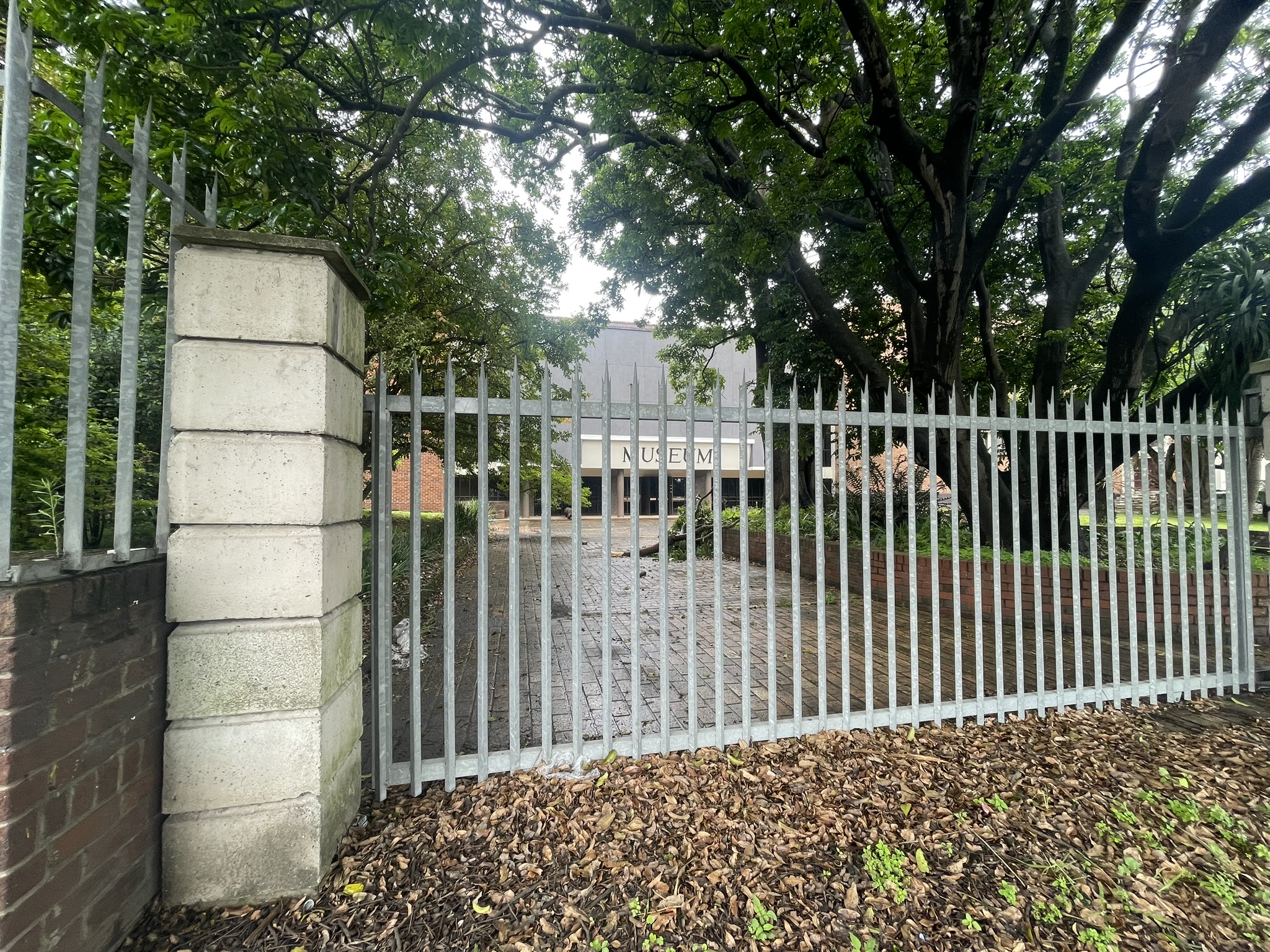
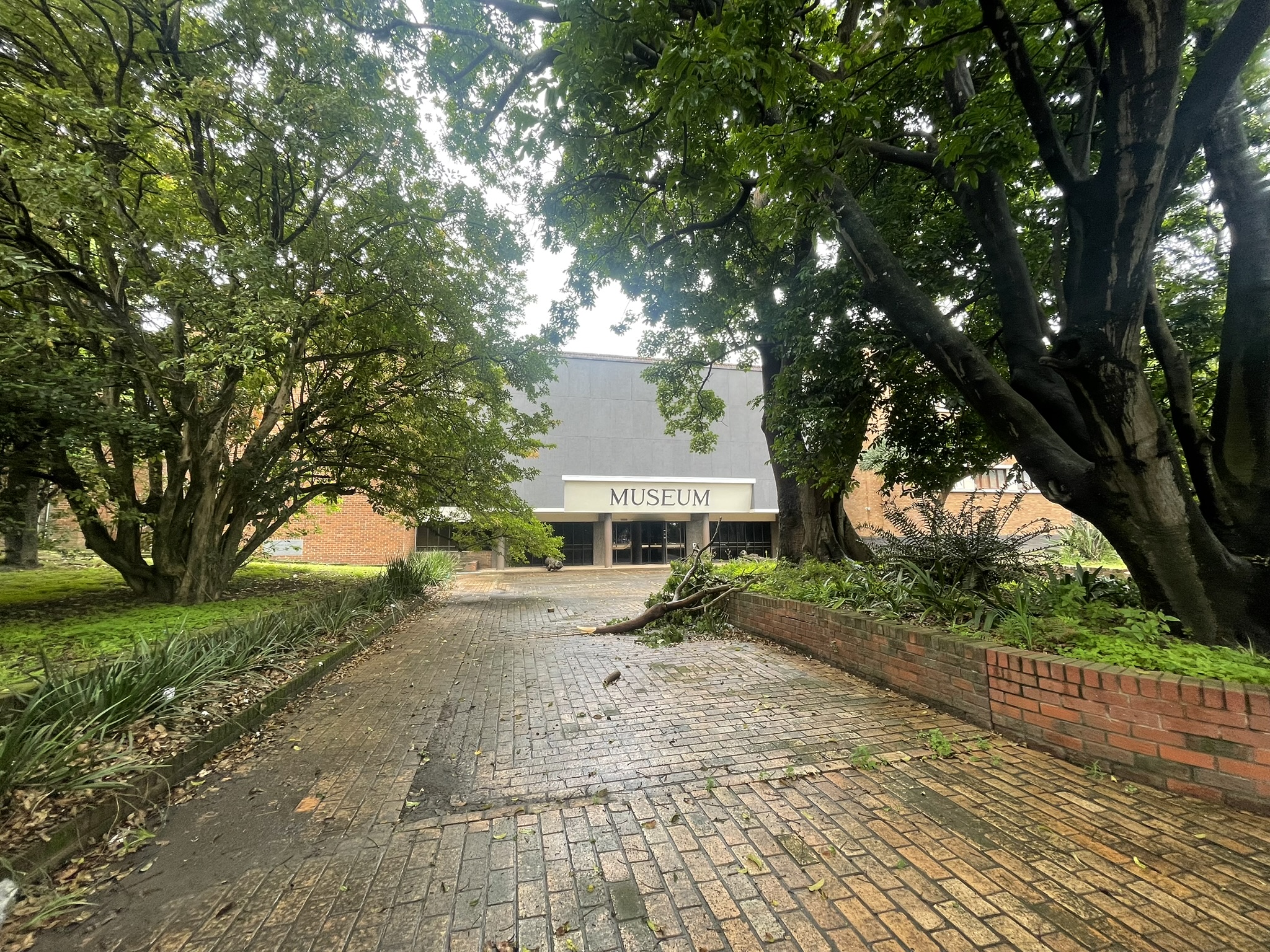
He took us upstairs to the German Settler Gallery and stopped in front of two oil paintings on canvas, framed and behind glass. The first depicted The Arrival of the British German Legion at Panmure (now East London) in February 1857 and the other the arrival of The Agricultural Settlers in East London, 1858. They were painted by Caesar Carl Hans Henkel. The first was familiar to me. Kevin Cole highlighted the differences in the contracts offered the settlers by Governor, Sir George Grey, and expressed sincere admiration for the agricultural settlers as their contract was much tougher. The military settlers got free passage for themselves and their families, grants of land and a building grant commensurate with rank, free rations for a year and working tools. But they would be liable for military service for 7 years. The agricultural settlers had to pay their own passage and lands after 4 years and within 8 years and received rations for 20 days. Kevin Cole then excused himself, leaving us to explore the museum at our own pace.


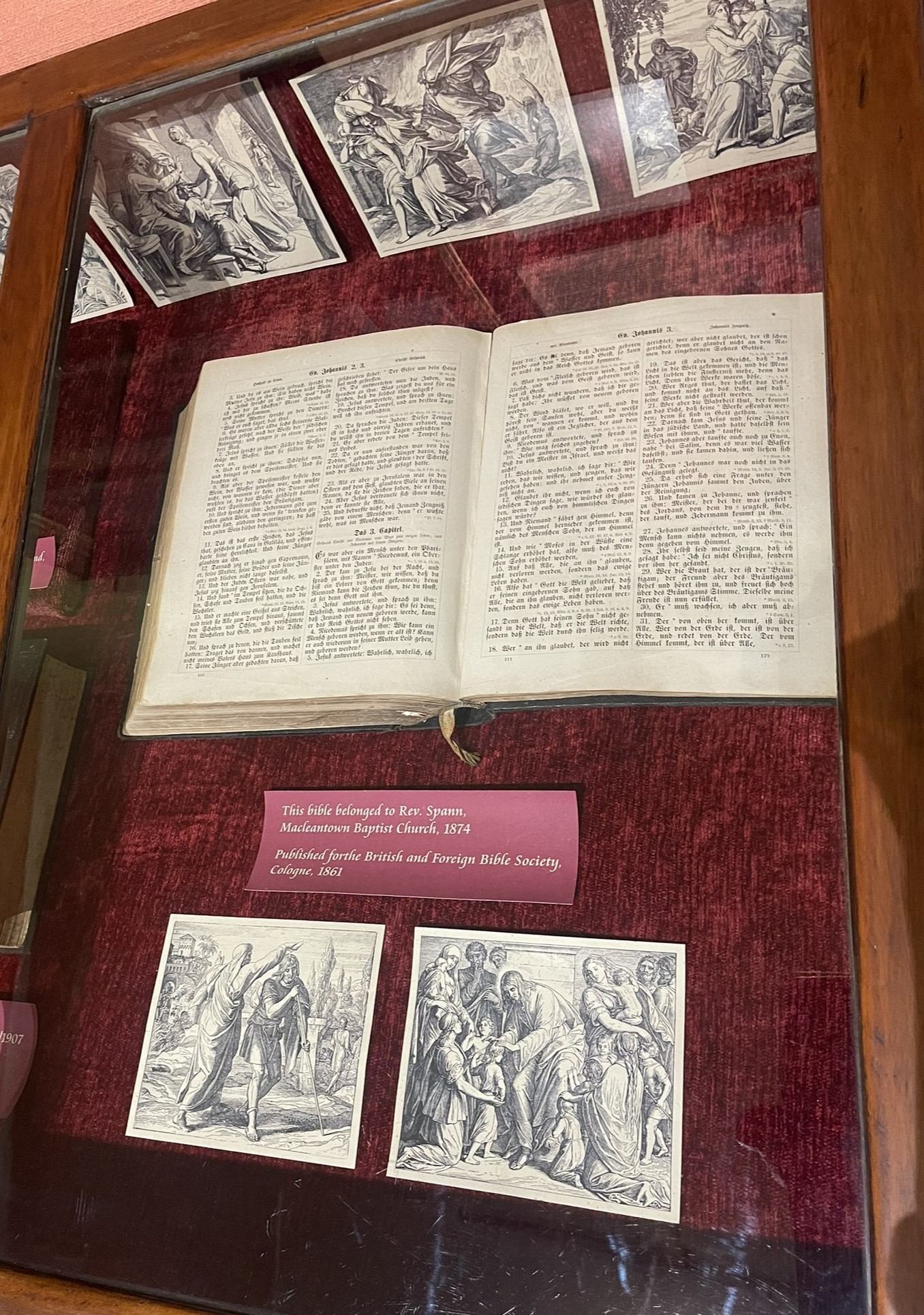

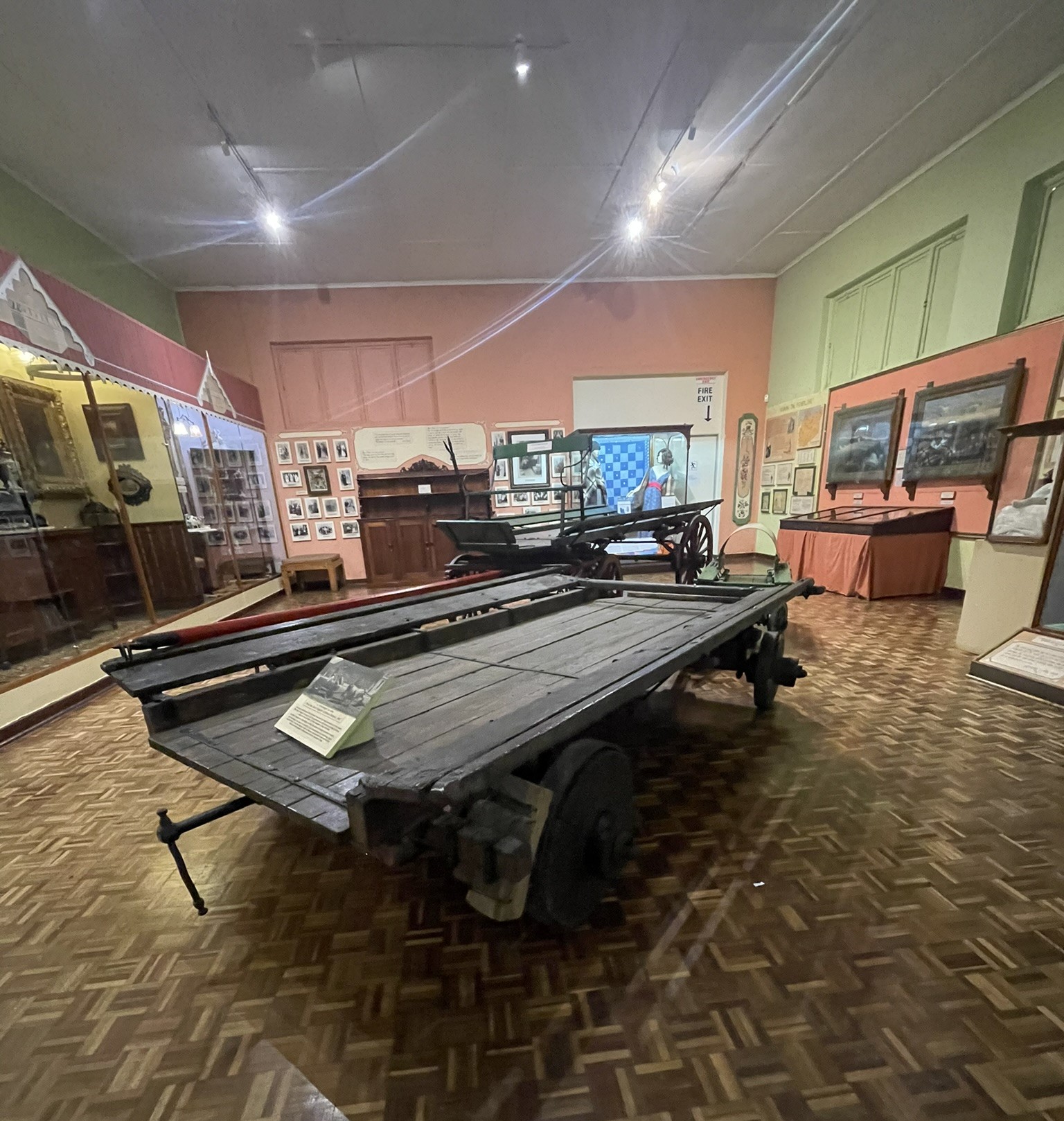
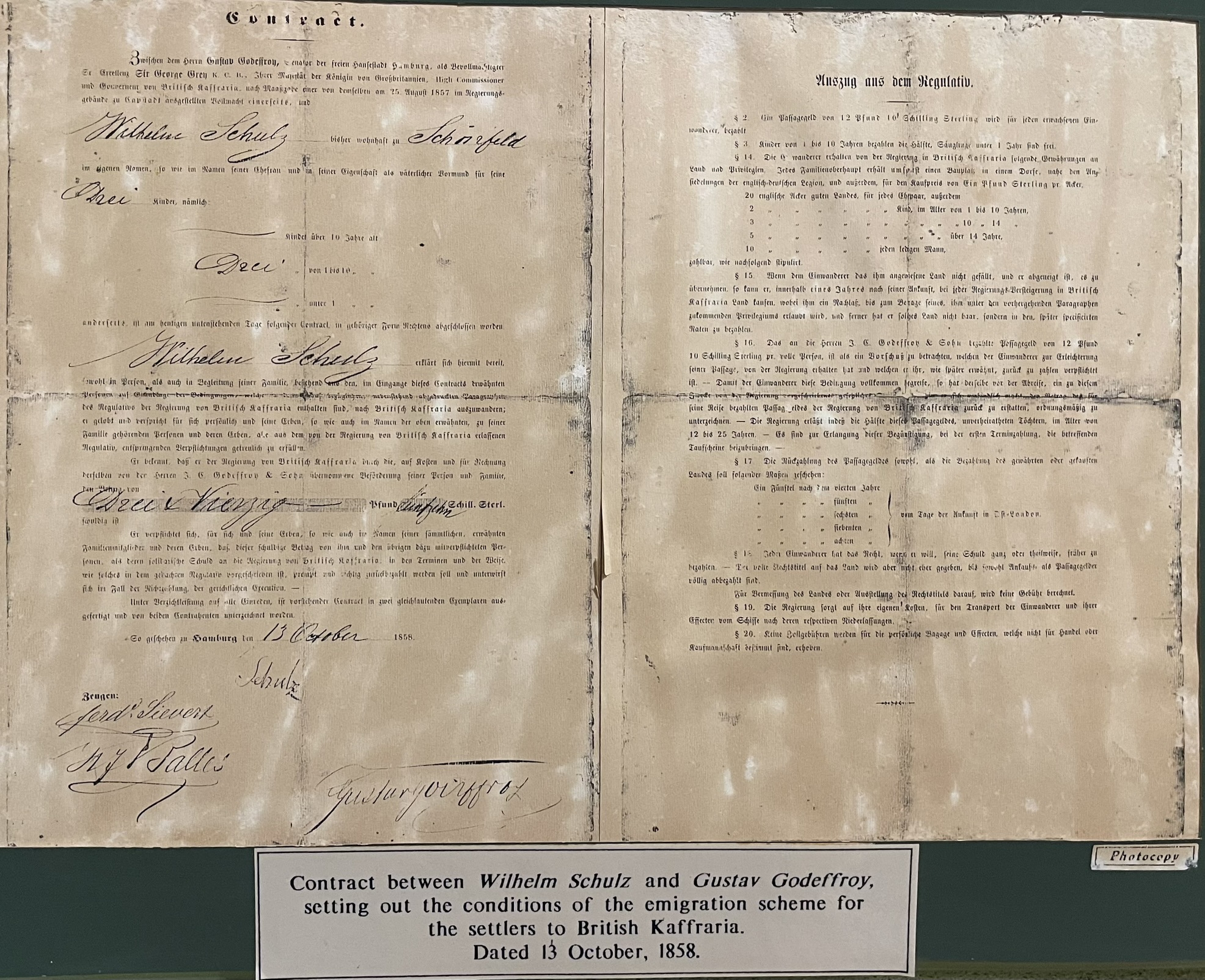


The German Settler Gallery was very interesting. There were several lovely photographs of the settlers, but none of my ancestors. I saw a bible that had belonged to Reverend Spann of the Macleantown Baptist Church, 1874. It was published for the British and Foreign Bible Society, Cologne in 1861. There was also a mealie cobber from the Kläckers farm.
**Gottfried Flieth and **Louise Henriette Spann came to South Africa in 1858 with 2 of their surviving daughters from their original 8 children; Marie Louise Flieth (1840-1916), and **Louise Wilhelmine Flieth (26th July 1845-1928), my great, great, grandmother. They sailed on the ‘Wilhelmsburg‘, along with two of Louise’s brothers, Christian and Gottfried Spann. They all settled in Frankfurt. Possibly one of these brothers, or one of their sons is the Reverend Spann whose bible can be seen in the museum case in the German gallery. I wondered if there was a record of the family in the front of the bible. I wish I had asked to look inside. I subsequently wrote to the Museum asking if any family information was recorded in the front or back of it. Unfortunately, there was no information found. Marie Louise married Johann Hermann Kläckers (1827 – 1901) and her sister Louise Wilhelmine went on to marry **Johann Michael Clur, my great, great, grandfather. Both Johann Hermann Kläckers and Johann Michael Clur were soldiers in the British German Legion, having arrived in East London in 1857.


Appendix XVIII, pages 285-287, of “For men must work’ by E.L.G. Schnell).
- http://www.eastlondon-labyrinth.com/germans/ship-wilhelmsburg.jsp
Interestingly, after having seen this website, my ’til then unknown distant cousin, Marilù Fiorillo contacted me. She is reading history and doing her dissertation on the diaspora of the French Huguenots in the territories of Brandenburg – Prussia, caused by the extreme religious intolerance that had spread in Europe in the mid-sixteenth century, pervaded the entire seventeenth century and culminated with the infamous Thirty Years’ War. Our common ancestor is Gottfried Flieth. One of Marie Louise Flieth and Johannes Hermann Kläckers’, 6 children was Hendrietta Kläckers, Marilù’s great-great-grandmother. The graves of Gottfried and Louise Henrietta Flieth, Johannes Kläckers and Marie Louise Flieth, and Johann Michael Clur and Louis Wilhelmine Flieth are in the German Cemetery in Frankfurt. Gottfried Flieth died at Johann Michael Clur’s house in Wiesbaden. On his death certificate we can see Johann Michael Clur’s signature and that Gottfried’s parents were **Johann Flieth (1777 – 1865) and **Elizabet Desmaretz who may have been of noble origin.
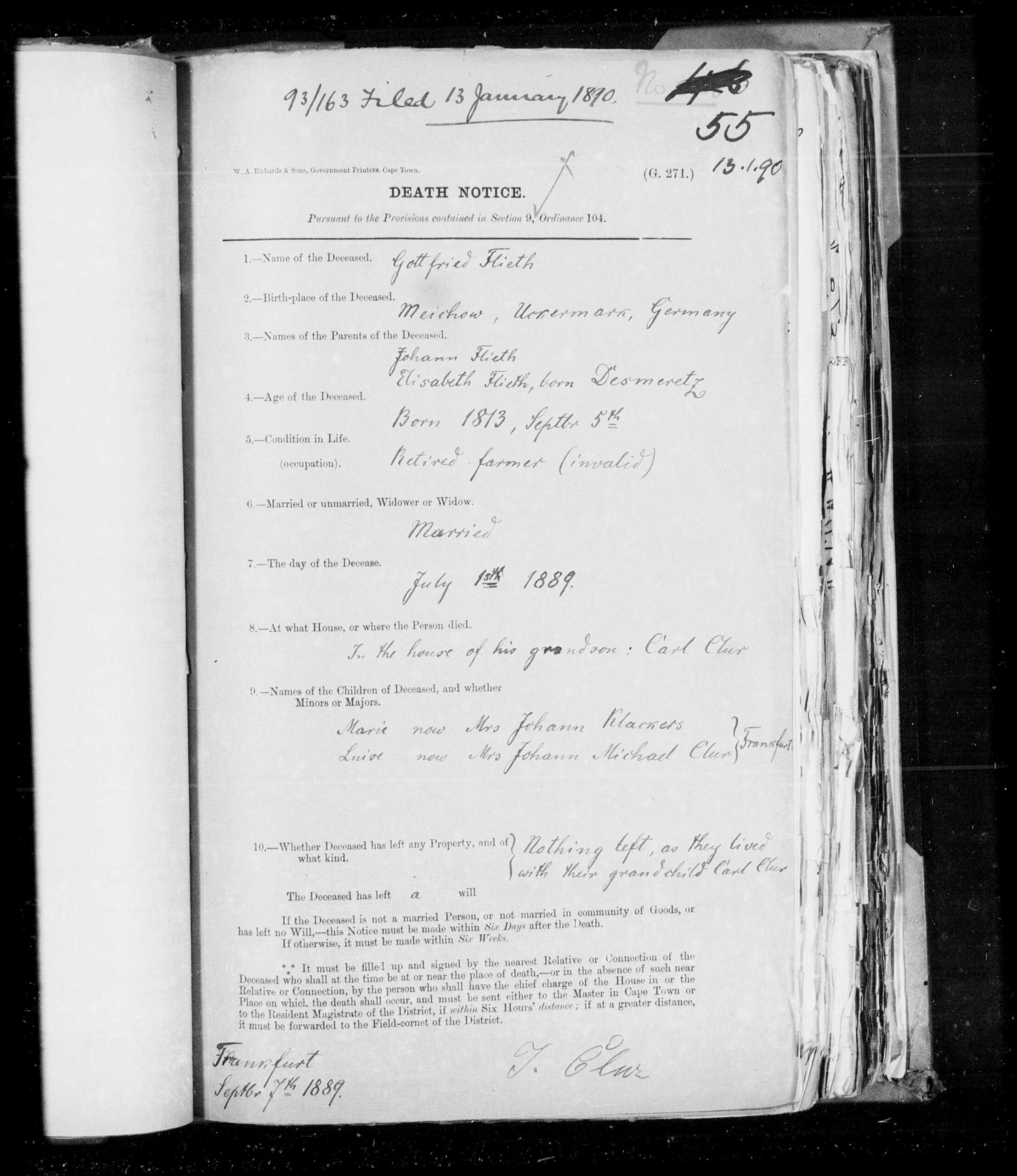
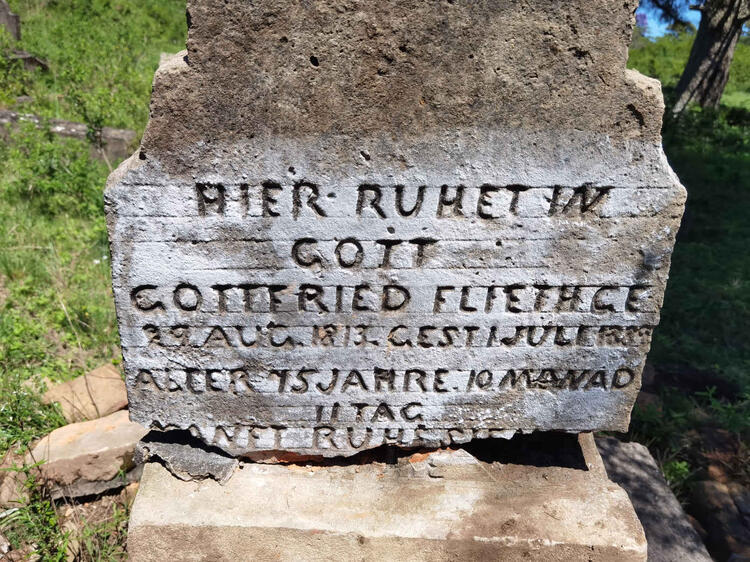

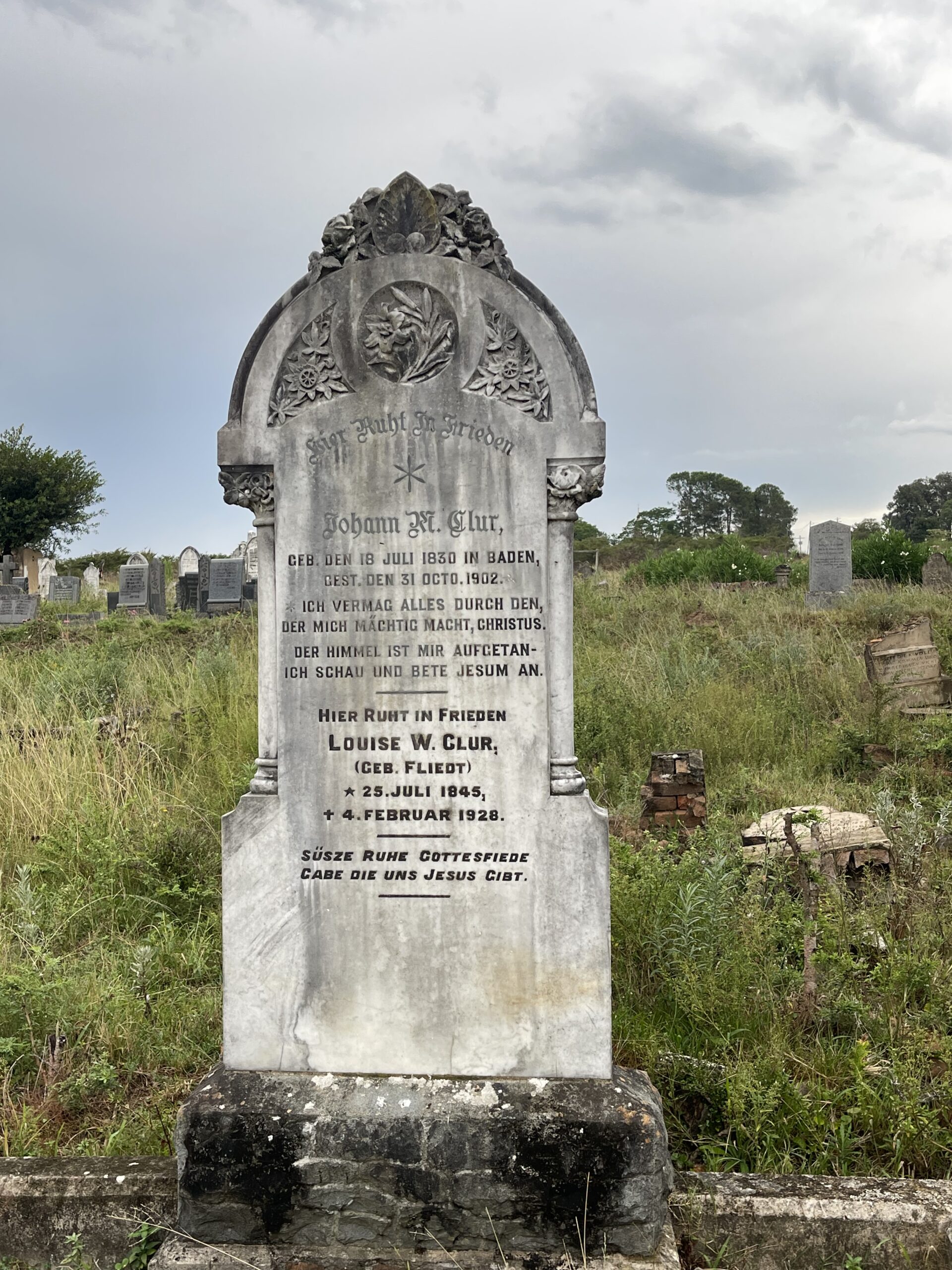
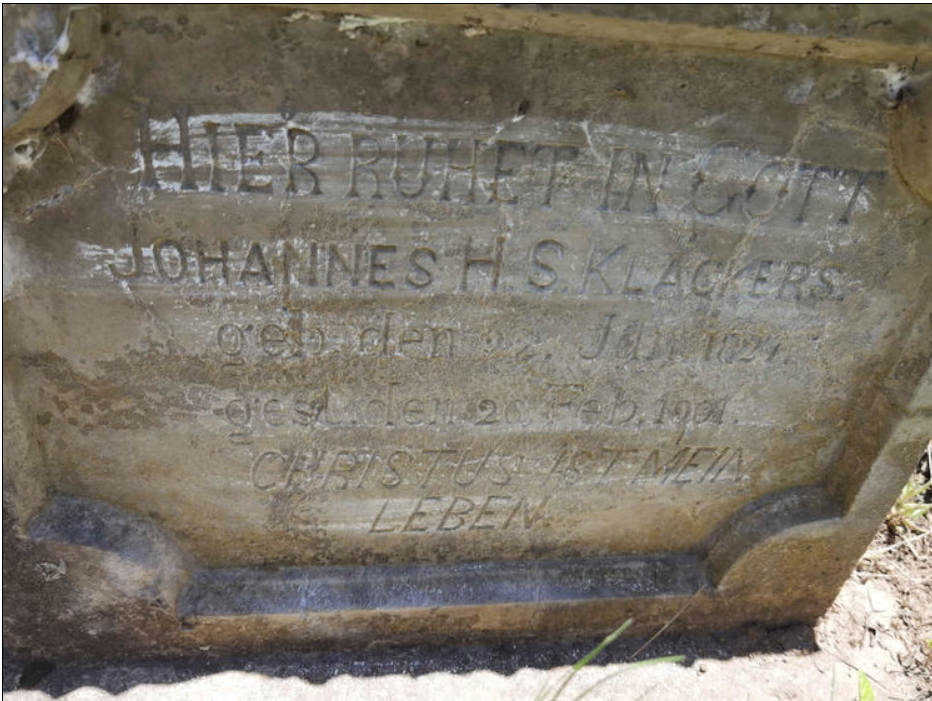
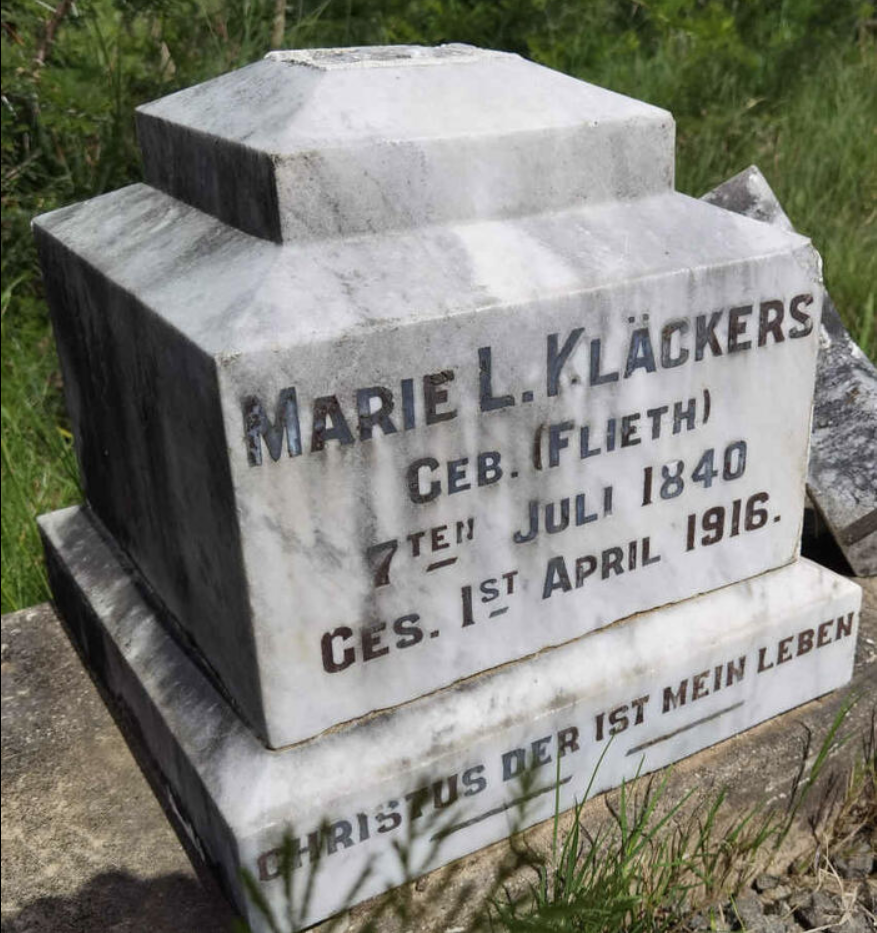
The allure of a noble ancestry has been lingering for some time in my family. When my mother and father squabbled, my mother referred to my father was a “German peasant”. This was based on the desperate state of many of the German emigrants fleeing the effects of the industrial revolution on Europe in the 1800’s. This made the reality of an aristocratic lineage seem remote. However, my other great, great, grandparents on my father’s side, **Marie Wilhelmine Werbelow (1833-1923) and **Carl Georg Puchert (1834-1914), a coachman from Rossow, Germany, sailed to South Africa in 1861 being part of a later group of German settlers to Kaffraria. Folk law suggests that Wilhelmine was of aristocratic descent with possible ties to the Werbelow or Hanseberg estates. There is also talk of Carl being the son of a French governess with the surname Puchert, and a Baron “von Olschman” or his son. Their true origins remain unknown. Notes above the picture of August Puchert and his grandparents that I got from the East London Museum, say that August’s grandparents were Zastrows, and that he was the son of Wilhelmine Othilde Zastrow and William Carl Puchert, son of Carl Georg Puchert.


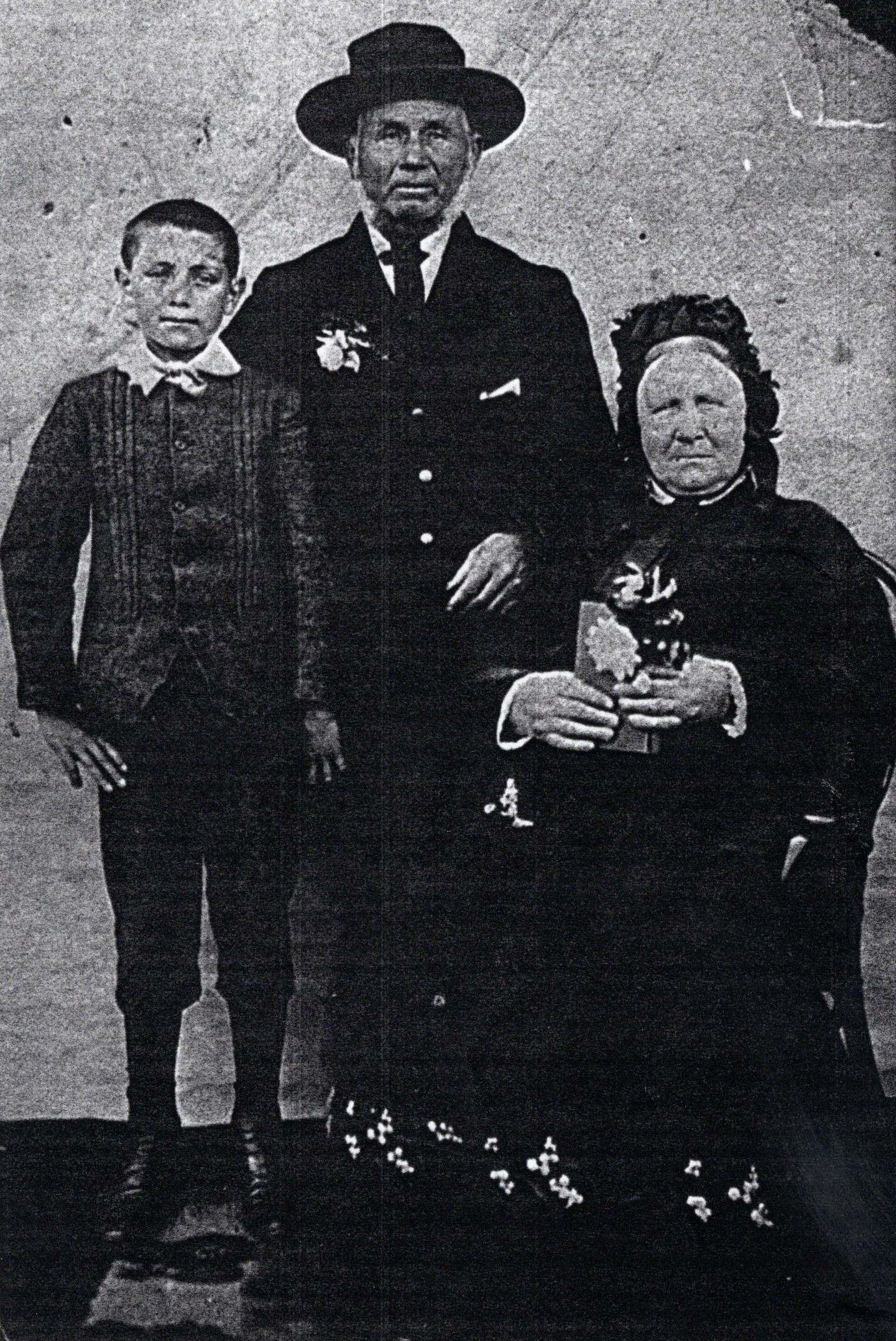

In the museum’s list of the states and principalities (Germany was at yet not unified) where the settlers came from, I found the name Spann under Uckermark, but no mention of the name Flieth. My cousin Annemarie Xavier, (great granddaughter of Johann Michael Clur), remembers her aunts telling her that one of their ancestors was a “French Countess”. This she also found a bit far-fetched knowing that they mostly came from Uckermark and were generally thought to be peasants. However, our aunties may not have been fantasizing, as French Huguenots did indeed settle in that area.
I now know that not only Johann Michael Clur, one of the military settlers of 1857 but also Gottfried Flieth one of the agricultural settlers of 1858, were descended from French Protestant refugees who left France under Louis XIV, mainly after about 1680 for reasons of religious persecution. Gottfried Flieth’s Huguenot descendants arrived in Brandenburg – Prussia, while those of Johann Michael Clur travelled via Switzerland to settle in Friedrichstal and Welschneureurt near Carlsruhe in Germany.
Later that day, when I finally did speak to the historian, Zuko Blauw, but only on the phone, he had clearly not yet opened my emails. Doing the research would take effort and require some time, he said. However, he promised to look up the information, scan it and send it to me via email. He was true to his word and sent me information including the above photographs of the Pucherts, their family tree and an obituary written for Matthias George Edward Puchert who died in 1968.
My mother used to visit the East London Museum often as a little girl to see the first live Coelacanth caught off the South African coast after it had been thought to be extinct for 65 million years. Quite by chance her father, William Edward Barker, used to teach at Selborne College for boys, a school just behind the museum. She, herself, attended Clarendon High School for girls which is just across the road from the museum. When she was about 13 years old, the family left East London and moved to Peddie where my grandfather, was made headmaster of the school and my grandmother, **Doris Anne Barker, (née Watkins), was a teacher. She even taught my mother! As the school only went up to standard 8, my mother went to a boarding school for the last two years of her schooling.

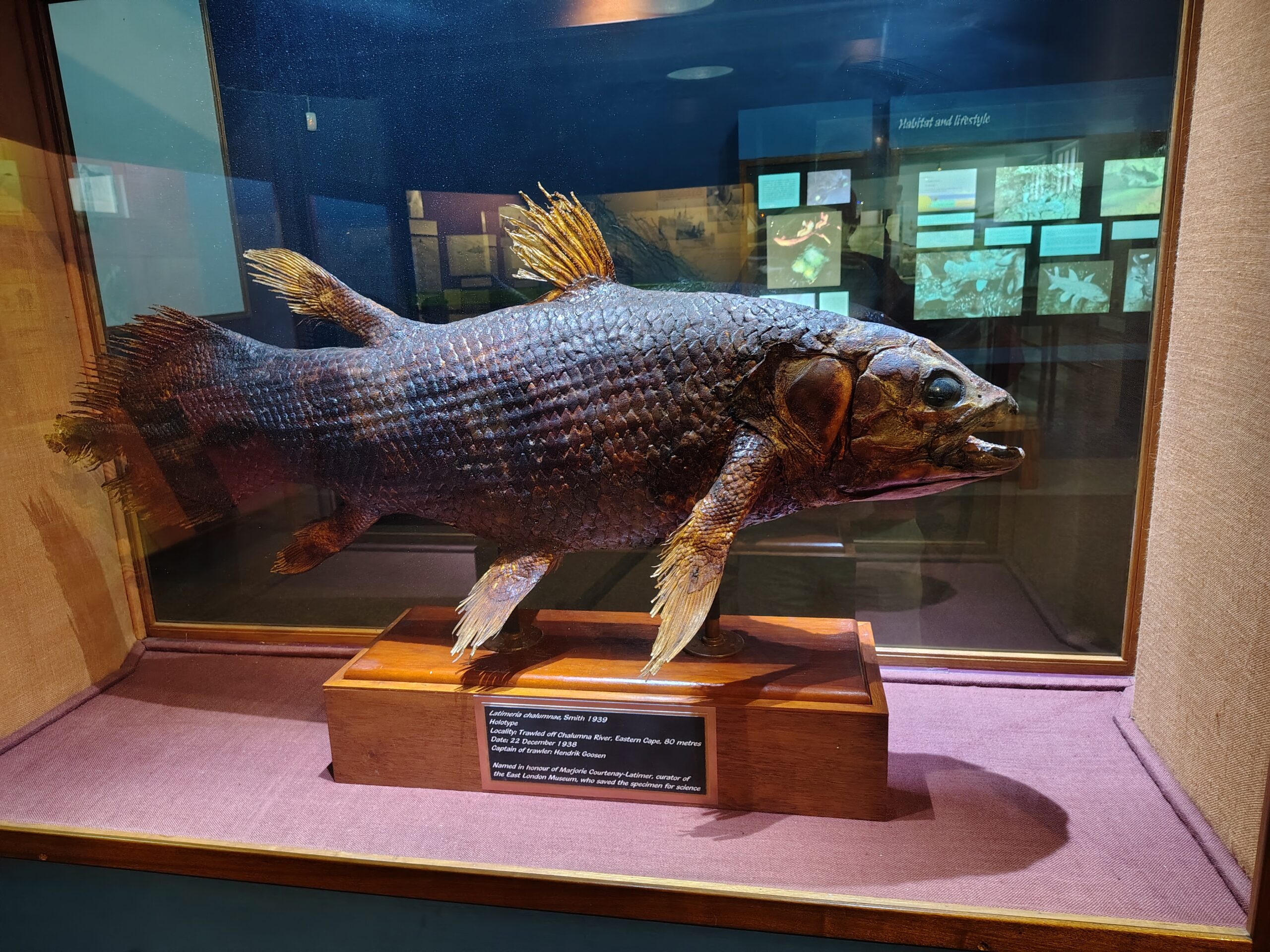

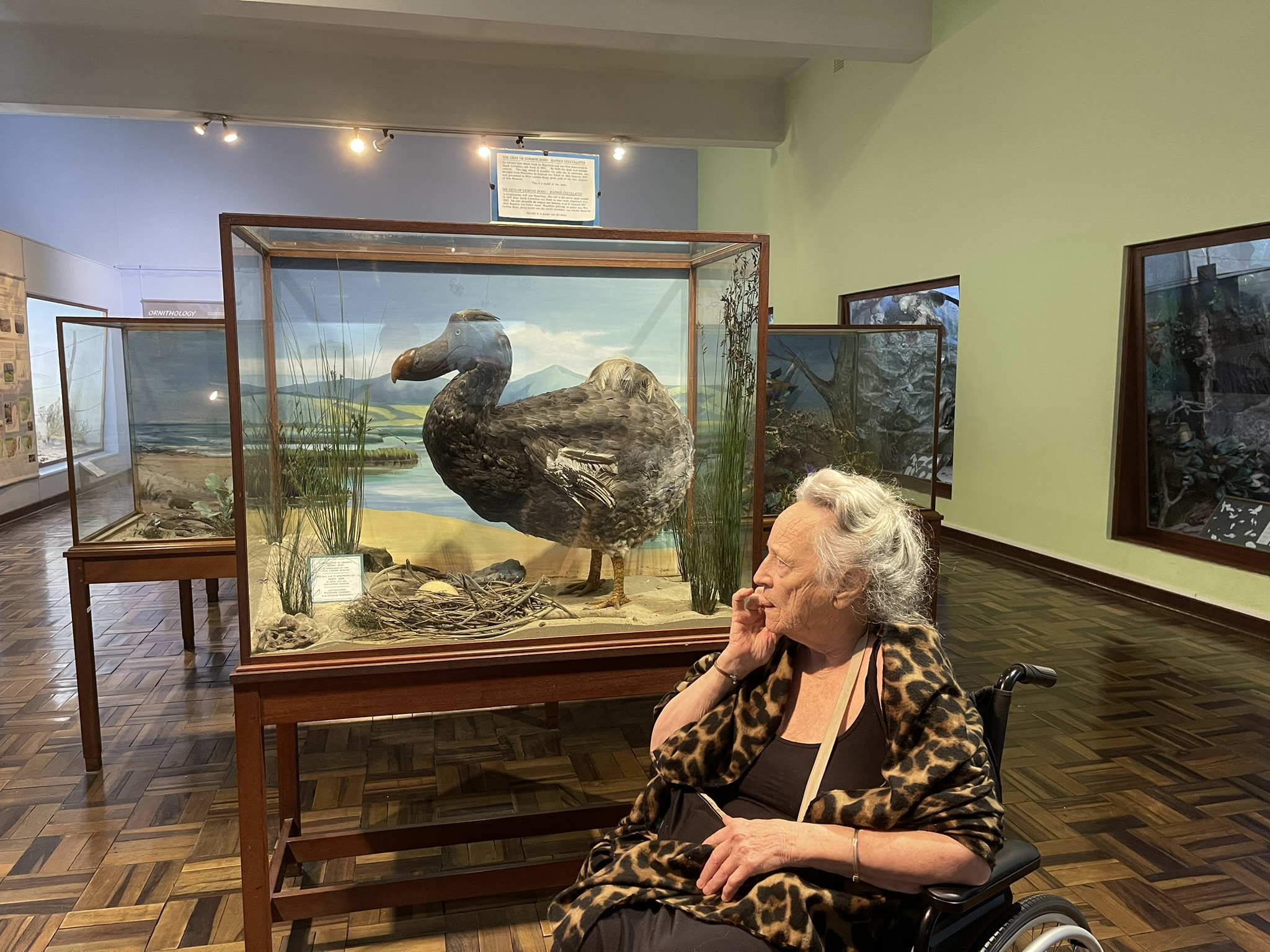
We had brought our own wheelchair so that I could push my mother around the museum and allow her to enjoy some memories of her past. My mom enjoyed the antique furniture, having an extensive collection of Afrikaner furniture herself. She had been rather quiet on the road ‘til then, but as I wheeled her past the exhibits she spontaneously broke into prose, as she was known to do from time to time at the dinner table. As children we were frequently entertained by excerpts from Chaucer’s Canterbury Tales, or Shakespear’s Macbeth or Hamlet. I soon could also recite lines from the witches’ scene in Macbeth, acting it out during one of my school speeches. After the German Gallery we went on to view the extensive antique clothing and doll collections. “Kewpie, Kewpie, Kewpie doll, You are so pink and fat, I’m sure they feed you far too much, But I love you so that’s that!”, emanated from the wheelchair in front of me. In Shakespeare’s time a porcupine in a bad mood with its quills standing on end was something to be feared as it was thought that it could throw its quills. Viewing the porcupines stimulated, “I could a tale unfold whose lightest word, Would harrow up thy soul, freeze thy young blood, Make thy two eyes, like stars, start from their spheres, Thy knotted and combined locks to part, And each particular hair to stand on end, Like quills upon the fretful porpentine” – (Hamlet,1.5.15-20: – The Ghost to Hamlet).
I found the natural science, archaeological and paleontological exhibitions fascinating. I lingered for some time at the Dodo with its egg and have always had a special interest in the Coelacanth. The dramatic discovery of this fossil-fish by the then curator of the East London Museum, Marjorie Courtenay-Latimer, in 1938 and the discovery of a second specimen in the Comores in 1952 had caused much excitement. James Leonard Brierley(JLB) Smith, associate professor in organic chemistry and ichthyologist from Rhodes University, Grahamstown, was flown to the Comoros in a South African Air Force Dakota (later dubbed ‘the flying fishcart’) to retrieve the 1952 specimen on order of prime minister D.F. Malan. JLB Smith was the sole author of the subsequent publication in Nature describing the discovery and his identification of the Coelacanth.
Old Fourlegs, as JLB called it, is regarded as a living fossil because it has not changed much since its ancestors appeared 400 million years ago. It later transpired that the fish was not infrequently caught in the Camores. Coelacanths belong to a group of ancient fishes with lobed fins and jointed skulls. They are closely related to lungfish and tetrapods, the first vertebrates that emerged on land, but not directly as was originally thought due to their abundance of fins. They are equipped with an electric organ on their snouts for navigation in deep water, a fatty bladder lung for buoyancy, thick scales, give birth to live babies and have hollow vertebrae from whence the name from Greek koilos “hollow” and akantha “spine”.
My grandfather, William Edward Barker, was friends with JLB and his first wife Henrietta (née Pienaar). My grandfather studied chemistry at Rhodes University where I presume they first met. I remember my grandmother, Doris Barker, telling me what a scandal it was that JLB left his wife for his PhD student Mary Margaret Macdonald. However, together JLB and Mary shared a common passion making remarkable careers in ichthyology. I have my own old copy of the JLB Smith Fish Book which I used to make several watercolour paintings for a school project in standard 8. I found a “blaasoppie” or blowfish on the beach in Port Alfred one day and reassembled its skeleton after boiling off all the flesh. Three of these painting are hanging in my kitchen today. JLB committed suicide by cyanide poisoning in 1968 after struggling for many years with cancer. JLB Smith’s recently late son, William Smith, gave me pre-matric refresher courses in Maths and Science. He was an excellent teacher.
My mother and I paused for a long time examining the human fossil footprints. We tried to imagine how they were formed. After running our hands over the casts on display, a discussion of photograph positives and negatives ensued as some footprints appeared to be convex and others concave. We then turned to view the Hofmeyr skull, which was discovered in the Hofmeyr district in 1952 by Chris Hattingh. Special optically stimulated luminescence and uranium-series dating methods were used on the mud matrix in the skull revealing it to be 36 000 years old. Morphological examination of the skull indicated it to be distinct from recent groups in Subequatorial Africa, including the local Khoisan, and that it has a very close affinity with other upper Palaeolithic skulls found in Europe. This suggests that Upper Palaeolithic human groups in Africa and Eurasia may have a common origin.
Discussing previous theories about human evolution initiated “A Huxley is marrying a Darwin, a fact that no one can debate, for Huxleys speak only to Darwins, and Darwins speak only to apes.” The publication of Darwin’s “On the origin of a species” describing his theory of natural selection prompted the Great Hippocampus Question in the 19th-century. Richard Owen claimed that the possession of a hippocampus minor differentiated apes from homo sapiens. Thomas Huxley, however, after studying human and primate brains showed that both apes and humans posses a hippocampus minor, thus supporting the theory that man originated from apes.
My mother is a talented graphic artist, and as we had the wheelchair with us and I had seen the positive reviews of the Ann Bryant Art Gallery three blocks further down the road, we decided to walk there after leaving the East London Museum. Negotiating three blocks along busy Oxford Street was more difficult than we had anticipated. The narrow strip of asphalt on the sidewalk was irregular and patchy in parts. There was no wheelchair ramp at the corner near the robots (traffic lights) and my mother had to exit the chair to cross the roads. I guided her as she shuffled along in her long black dress, one of the hats we had bought at Tredici secured on her head with her leopard print shawl, taking small, quick steps in her flat bronze slippers.
As we walked, we passed a fenced-in monument, the veld around it somewhat overgrown. School kids wandered seemingly aimlessly around, and the houses were in need of maintenance. On one corner there was a large pile of rubbish. As we approached the garbage removal van arrived and the black plastic bags were loaded into the lorry. The garbage removal men wore rubber gloves and had scarves over their mouths and noses. All garbage not in bags was left behind strewn over the pavement. We had to negotiate the wheelchair through a mess of used milk bottles, paper and general detritus. Around the corner a white man was standing in front of his makeshift stall. He was selling small packets of wormy cheesy chips that he had filled from a much larger bag he had bought at a wholesaler.
The once grand house that makes up the Ann Bryant Art Galley was looking worn. The mix of contemporary art with the remaining art nouveau features in the interior was somewhat surreal. The stained-glass window was broken at the bottom and needed repair yet was still beautiful. I particularly liked the ceramic pots that were in the first room made by Nosipho Booi. A black plastic rubbish bag was positioned in the middle of the dark wooden floor in one of the upstairs rooms. It was covered with parallelly arranged sticks and soil upon which bits of marijuana plant, a pot with matches, an Old Buck gin bottle and an empty plastic paint bucket were balanced. It gave me a message of despair. I felt the eyes of the caretaker/ security officer following me intently as we moved through the rooms. I guess it was not every day that two white people walked in from the road pushing an old lady in a wheelchair.
Our next port of call was the German Settler Monument. We followed Google Maps through the “rougher side of town” to Esplanade Street, drove along it, but found no monument. Eventually, after the assistance of a very friendly local, we backtracked and found the Buffalo City Heritage Site – Heroes Park including the German Settler Monument, the Multi-Cultural Man, Heroes Park Deck and the Wall of Remembrance. It was surrounded by high, tightly meshed, metal fencing making the taking of pictures between the gaps almost impossible. Despite the sign saying it was open between 9h00 and 16h00, the gate was securely locked. When looking from far one could just make out “Den deutschen Einwanderern”, (In honour of the German immigrants), through the gaps in the fence mesh. I took some pictures of the Settler Monument from outside and walked around the enclosure, trying to get a glimpse of the mosaic murals in the distance.
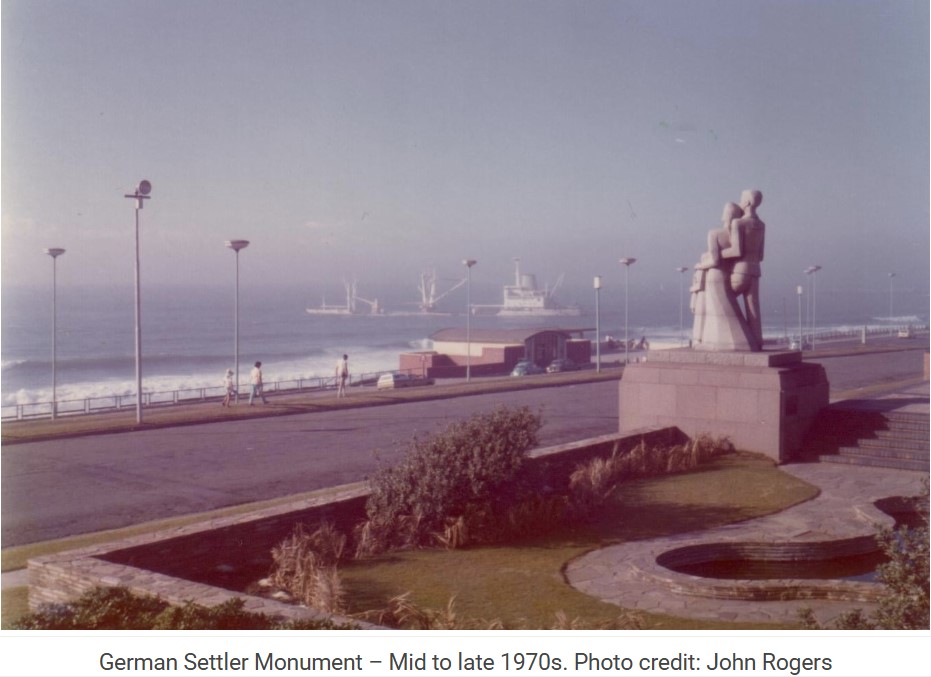
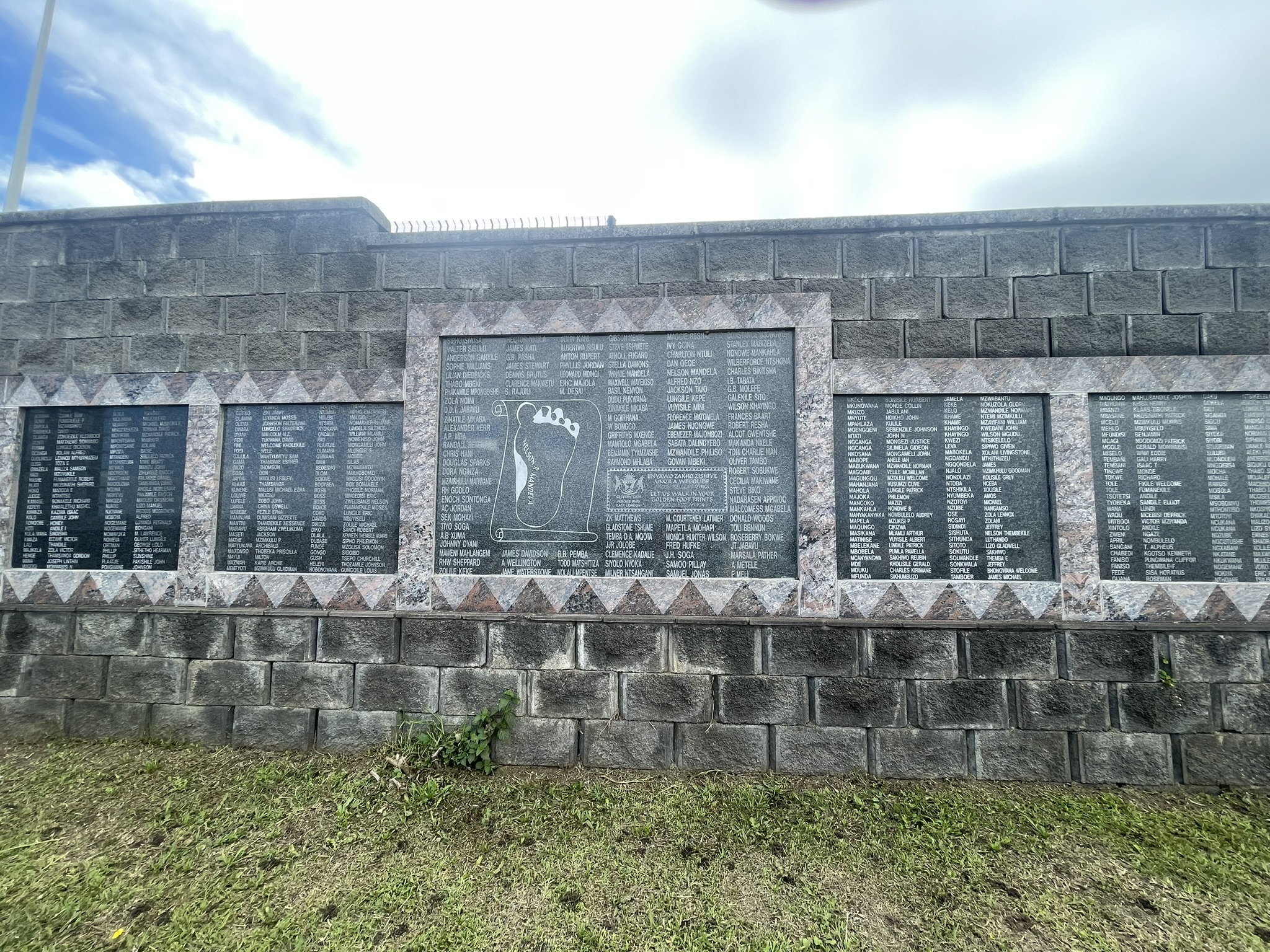
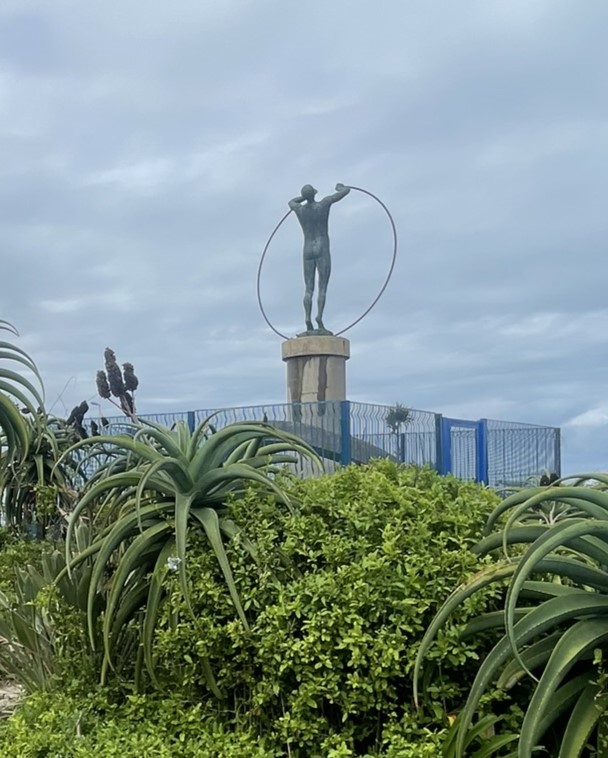
Copyright: © saclur
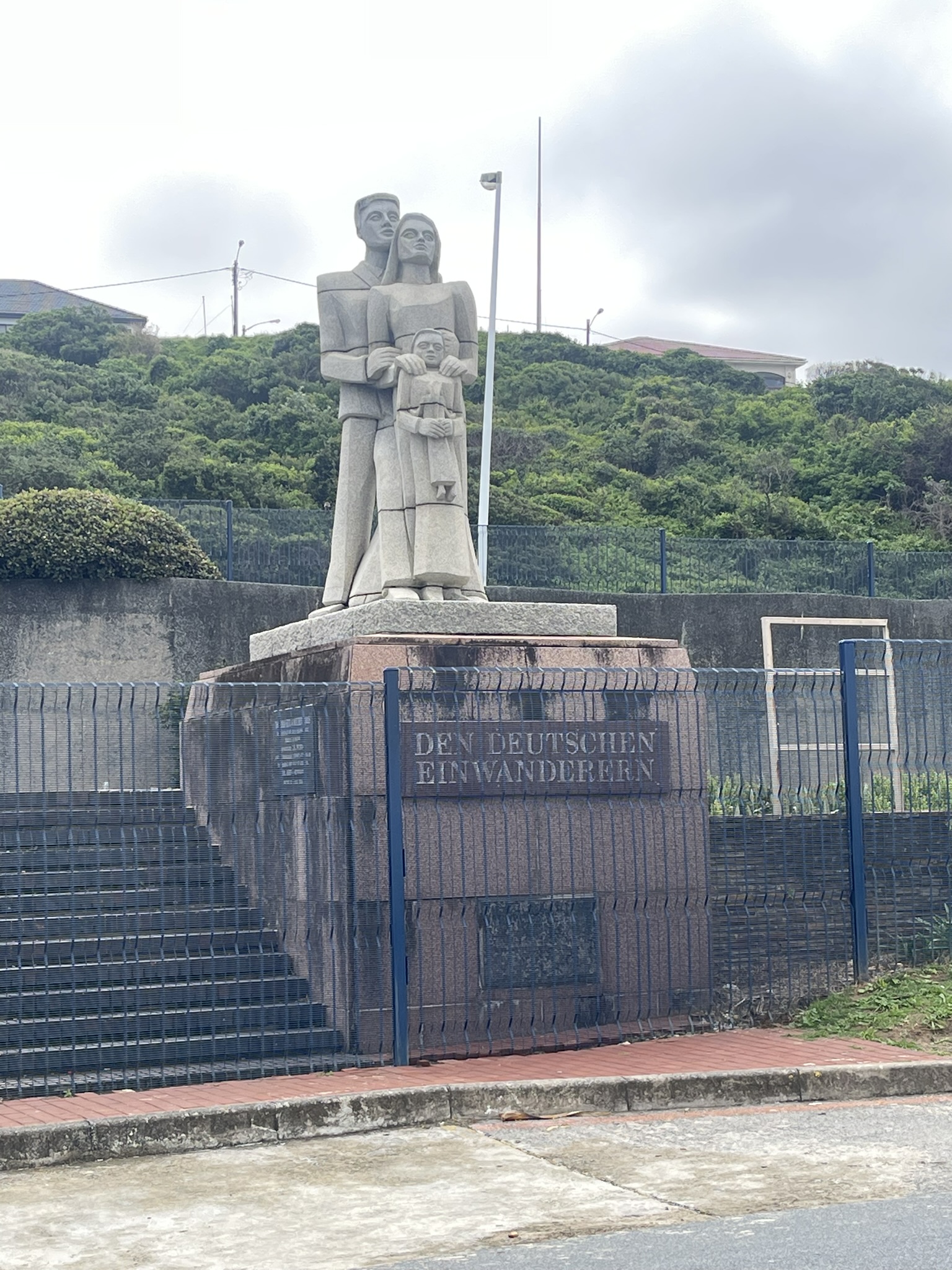
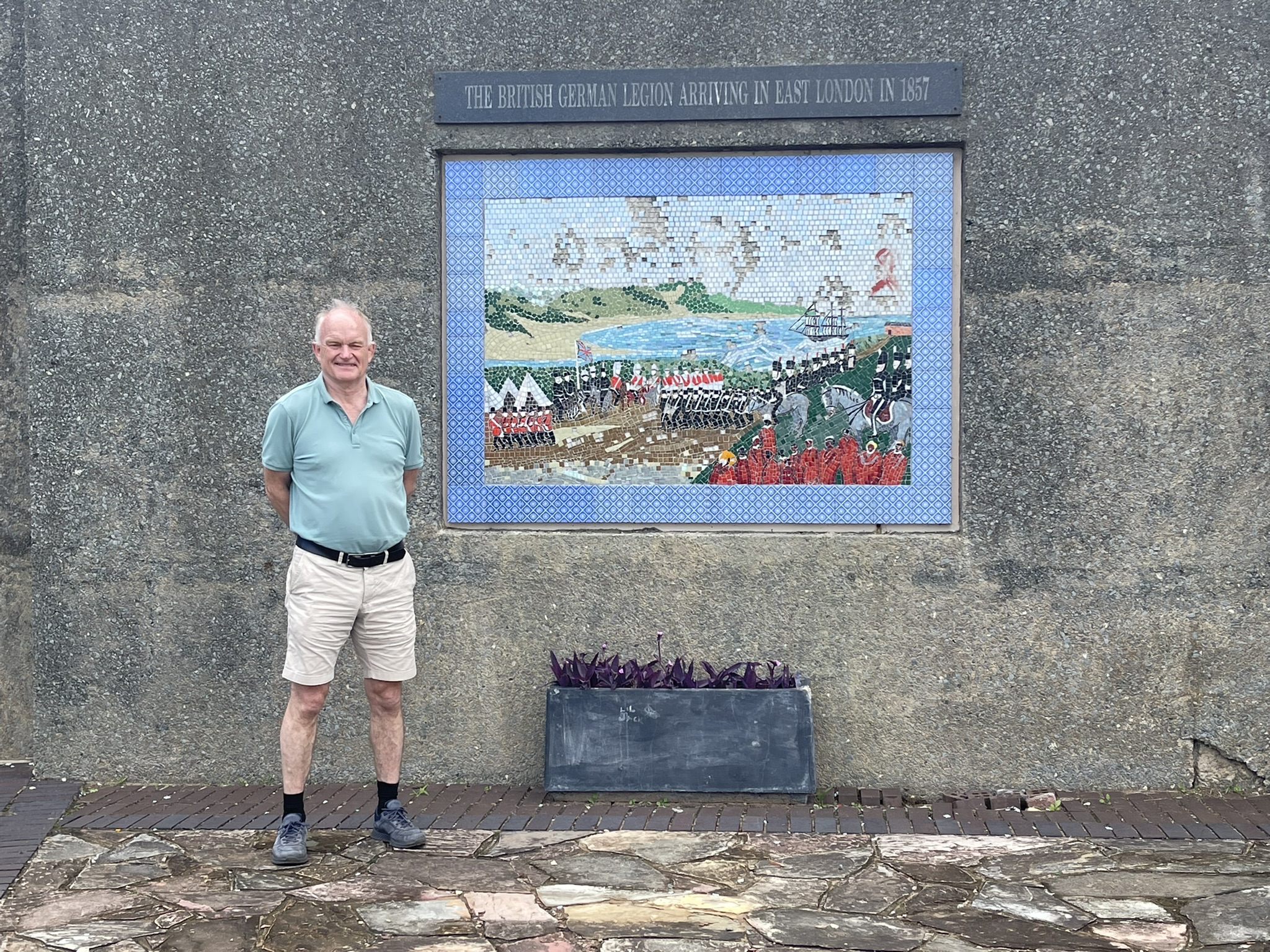
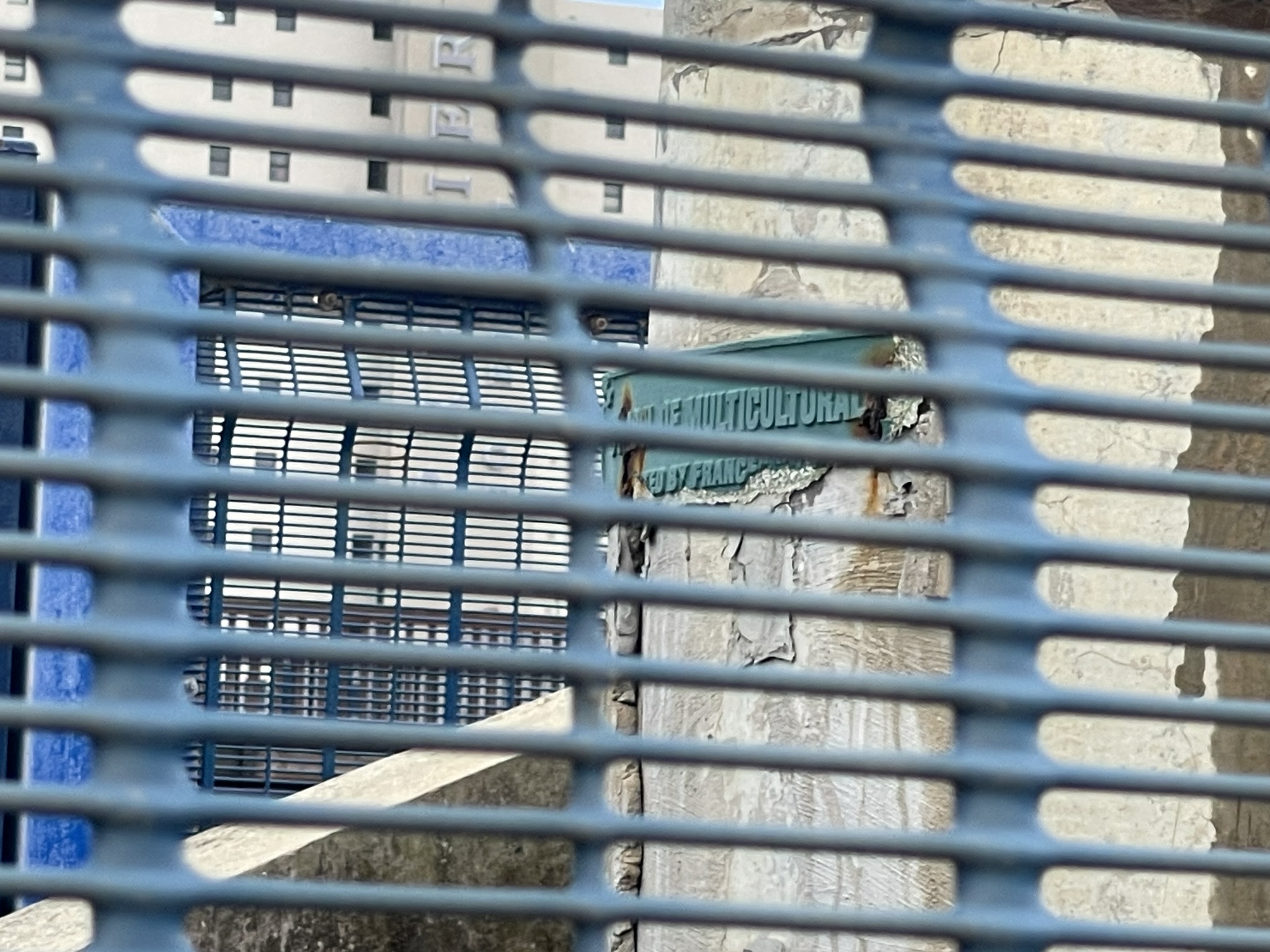
A man with long greying hair in a ponytail was taking pictures of a tourist travelling through South Africa on his motorbike. The back of his bike was adorned with stickers from all the places he had visited during his voyages. The man taking the photographs and a lady wearing an orange hat and vest saying, “Beachfront Community Security” approached me. The man asked if I wanted to enter the Park, told me that the person who usually attends it had not pitched up for work that day, but that he had a spare key. He fetched it out of his car boot and unlocked the gate which the lady then rolled open for me. I thanked them, made my way in and climbed the stairs towards the large footprint engraved with Nelson R. Mandela in the middle of the Wall of Remembrance. “Unyawo zakho zishiye umzila wegolide, Nkosi Sikelel’ iAfrika – Let us walk in your golden footprints, God Bless Africa” was engraved in the marble along with the names of important people who contributed to the anti-apartheid struggle. I turned and looked towards the ocean like the man, woman, child and doll of the German Settler Monument, taking it all in. The Multi-Cultural Man, a bronze sculpture created by Italian artist Francesco Perilli, also looked towards the sea. His faceless figure depicted in the middle of the earth uniting two meridians, symbolizing the universal humanity of all cultures. He was enclosed in yet another fence, the gate of which was not opened for me. I noticed that the doves that used to help by lifting other meridians and the additional meridians were missing. I wondered what had happened to them. I later found a report, When doves cry: Vandals rip off Multicultural Man’s flock in DispatchLIVE. Vandalism and theft can not be condoned, yet I think I prefer the simplicity of the new man. Squinting through the slits in the fence I could almost make out the word “multicultural” on the weathered plaque below the sculpture. Behind the German Settler Monument sculpture the mosaic murals depicting the arrival of the military settlers, the settlement sites and aspects of the settler’s lives were also weathered. The mosaic murals have replaced five large bronze plaques designed and made by the German sculptor, Bodo Kampmann that were stolen in the late 1990s. There were mosaics missing, some lying broken on the ground near by.
Back in the car “1984” continued as we started our return to Cape Town. Winston Smith, the main protagonist, was describing his work for the Ministry of Truth which required editing books and newspaper articles. People often disappeared if they had been reported for alleged crimes against The Party. Once vapourised, any evidence of their existence was erased and a new truth created. “Who controls the past controls the future. Who controls the present controls the past.”
Wilfried wondered if the current South African history books differ from those I used when a scholar. I replied that I imagined that the focus must have changed over the years. The history I learnt told the story of the white immigrants mainly, with a limited focus on the history of the indigenous populations. We philosophized about changes in context, emphasis and expression over the years as we moved into an era of political correctness and wokeness. I thought about the 16th December, coincidently the day I got married. It used to be known as Dingaan’s Day. I remember learning about it at school as a day of celebration after the Voortrekkers’ victory over Zulu warriors near the Ncome River in KwaZulu Natal. Ten to twenty thousand Zulu warriors led by Dingaan’s generals Dambuza (Nzobo) and Ndlela kaSompisi attacked the ~470 Voortrekkers Afrikaners led by W.J. Pretorius and S.A. Cilliers. They entered a covenant with God that should they win the battle they would keep this day for eternity as a special day of thanks. The Voortrekkers, equipped with guns, repelled the Zulus killing 3000 of them. The blood of the casualties flowed into the Ncome River turning its water red, hence the battle’s name, “The Battle of Blood River”. The 16th December has remained a holy day or public holiday in South Africa since then, however its name and significance has changed over the years. It started out as “Dingaan’s Day”, then became “The day of the vow” or “The day of the Covenant” and is currently “The Day of Reconciliation” and is intended as a day of celebration of the reconciliation between Blacks and Whites in South Africa.
“War is peace. Freedom is slavery. Ignorance is strength,” 1984 continued. Oceania was perpetually “at war” resulting in constant poverty and hunger, the inhabitants barely surviving on their rations.
Wilfried is the son of a tulip bulb farmer. He remembers the tales his mother told of the winter of 1944/5. In the Netherlands people were starving in the cities. The Germans were also starving, but they just stole what they needed. Amsterdam city dwellers, used to wander into Wesfriesland where Wilfried’s parents lived, hoping to trade what they had for tulip bulbs to eat. One evening a man knocked on the door of his grandfather, Opa Kaagman’s house. The man had no money and nothing more to trade. He had just given his last gold ring to a nearby farmer and was desperate. The man was welcomed in by Opa Kaagman and invited to share the family’s simple dinner with them. At table the man began to cry because he felt guilty that he was eating while his wife and children were starving at home. Opa Kaagman was enraged, marched off to the farmer in question and demanded he give the man his gold ring back immediately.
12th November – Port Alfred to Sedgefield

It would not have been right not to stop in Port Alfred considering its personal relevance to my mother’s family. So, after East London we decided to stay once again at the Beach House. Our welcome from Isabeau was as warm as we remembered from our previous visits. This time we had 2 rooms with an ocean view. Isabeau kindly assisted my mother up to her room as we unpacked the car. Looking out from the veranda adjacent to our rooms, we could see two dunes with the ocean between them. “A ridge of sandhills and a strip of beach separated the cattle camps and the mealie lands from the roaring sea that writhed like nacreous grey plasticine in the dawn light”, my mother spontaneously recited from her own short story “The Hunt” that was published in Contrast. (April 1974, Volume 9, No 1).
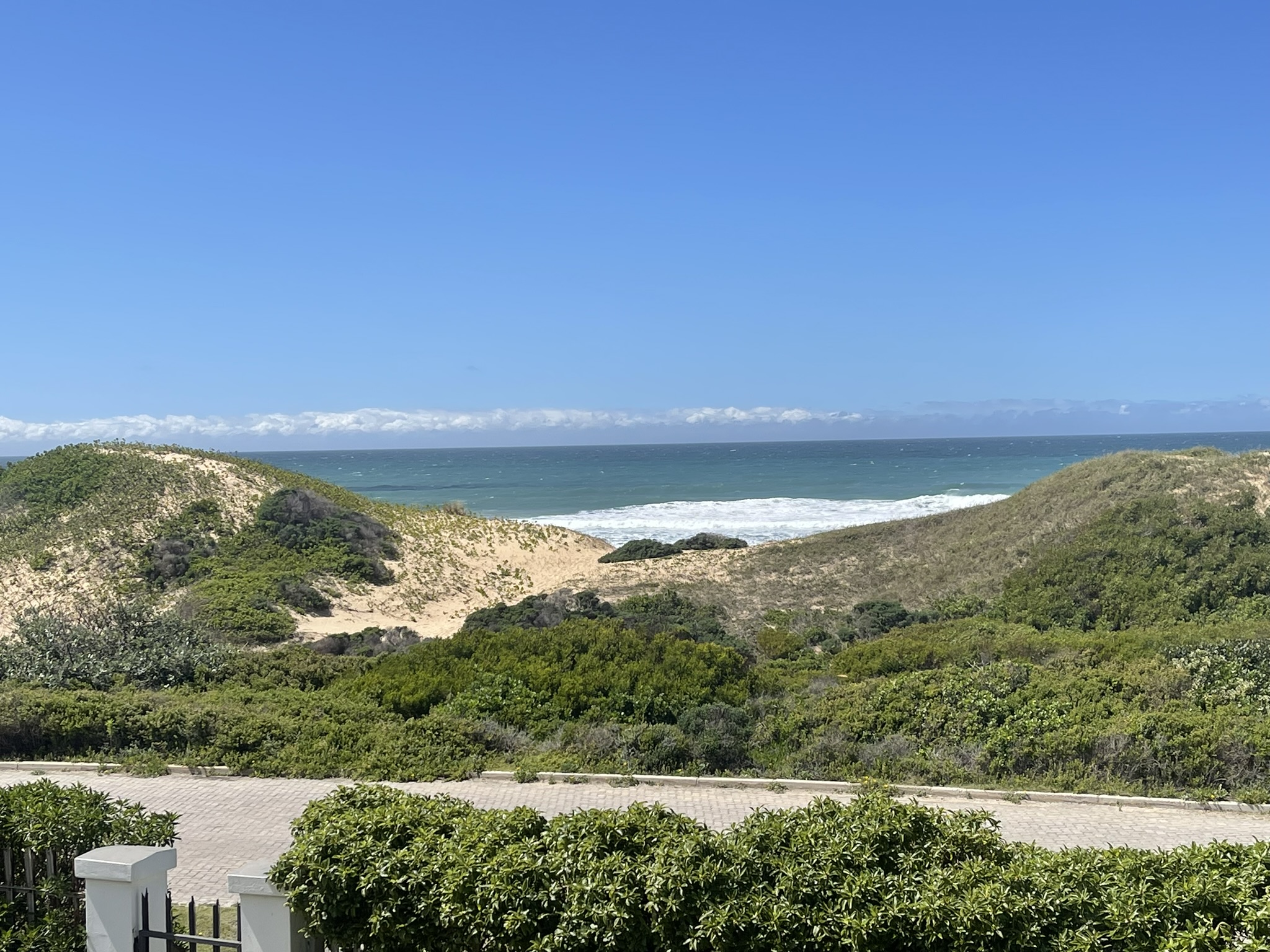
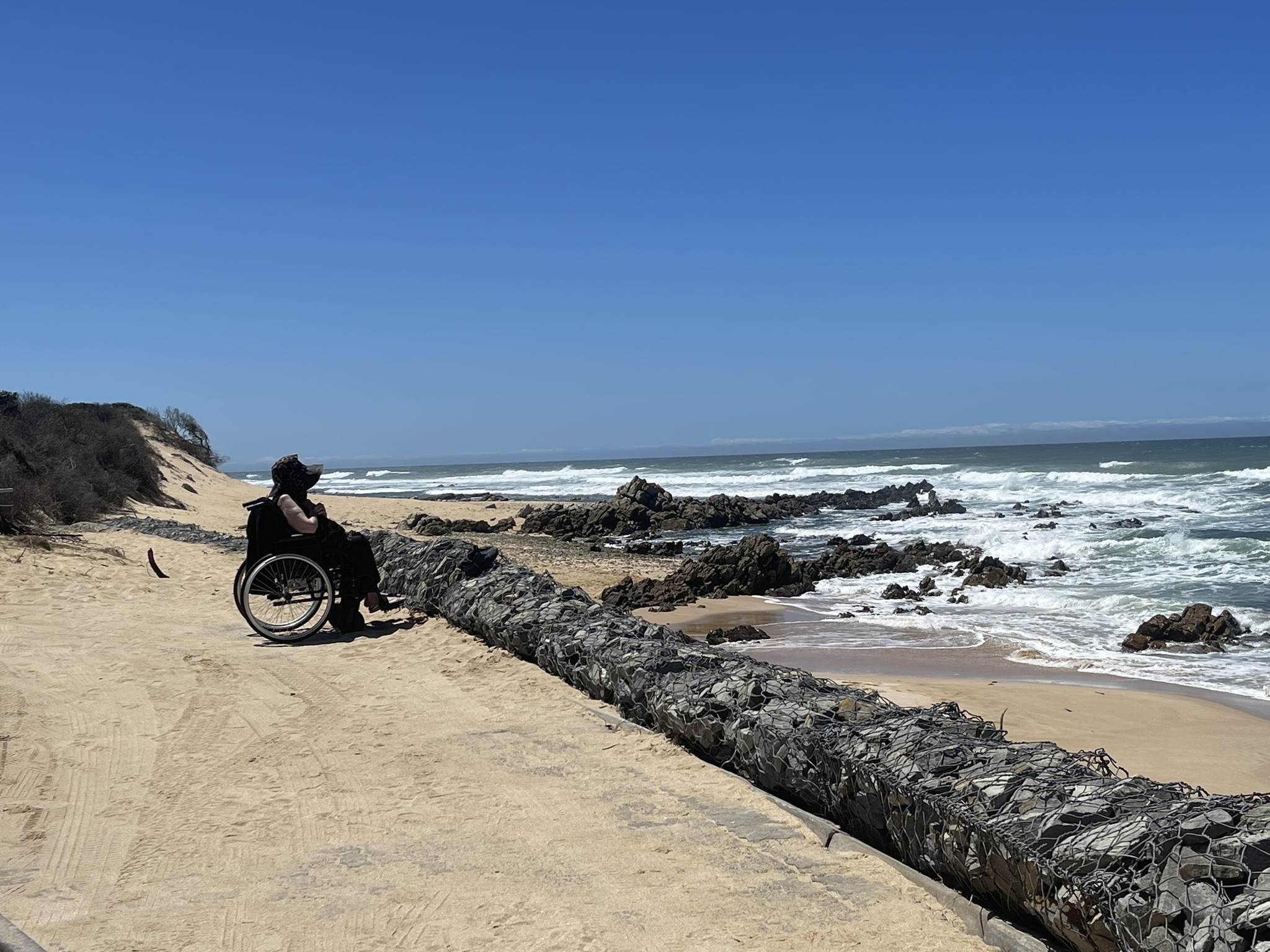
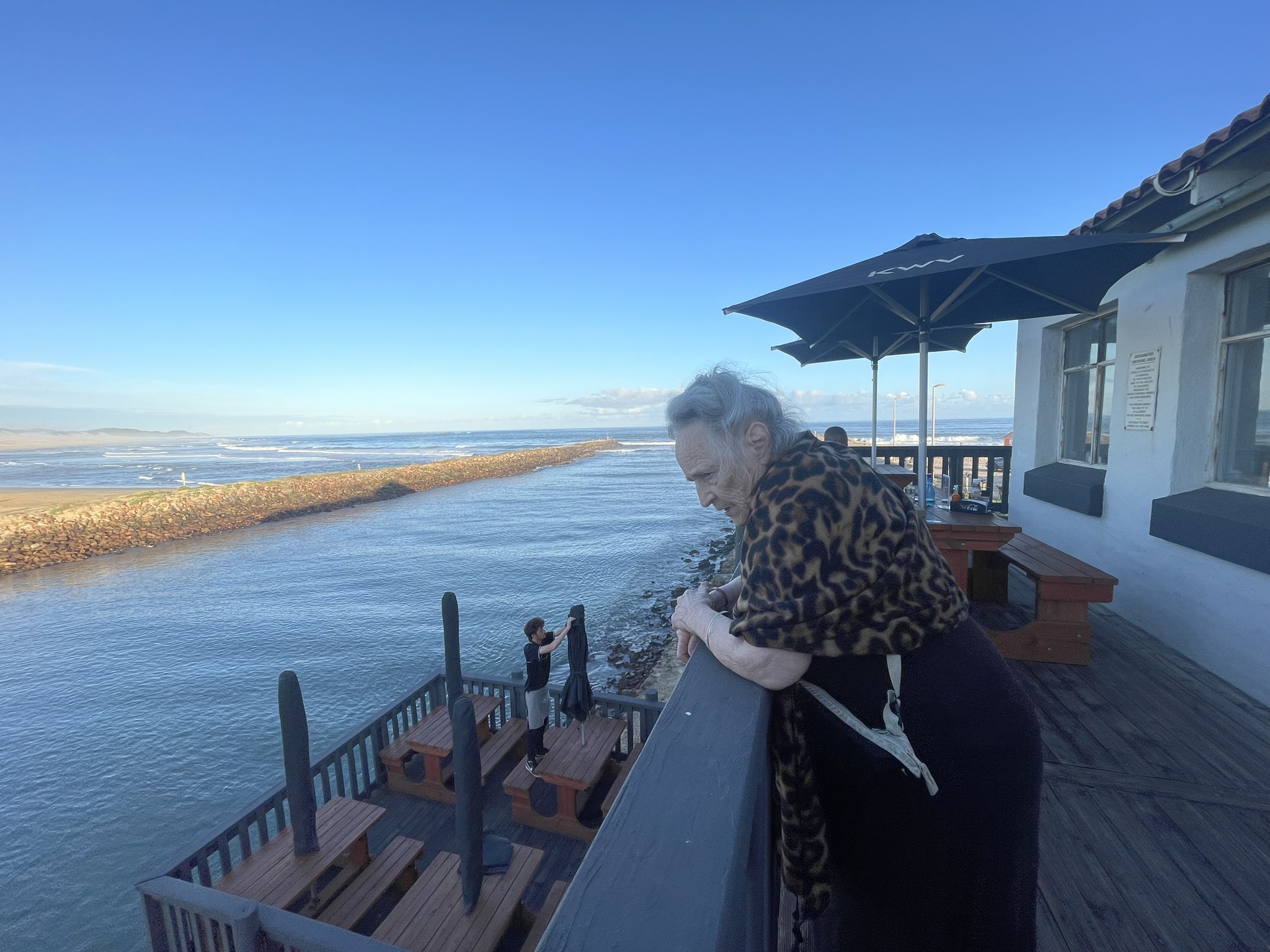
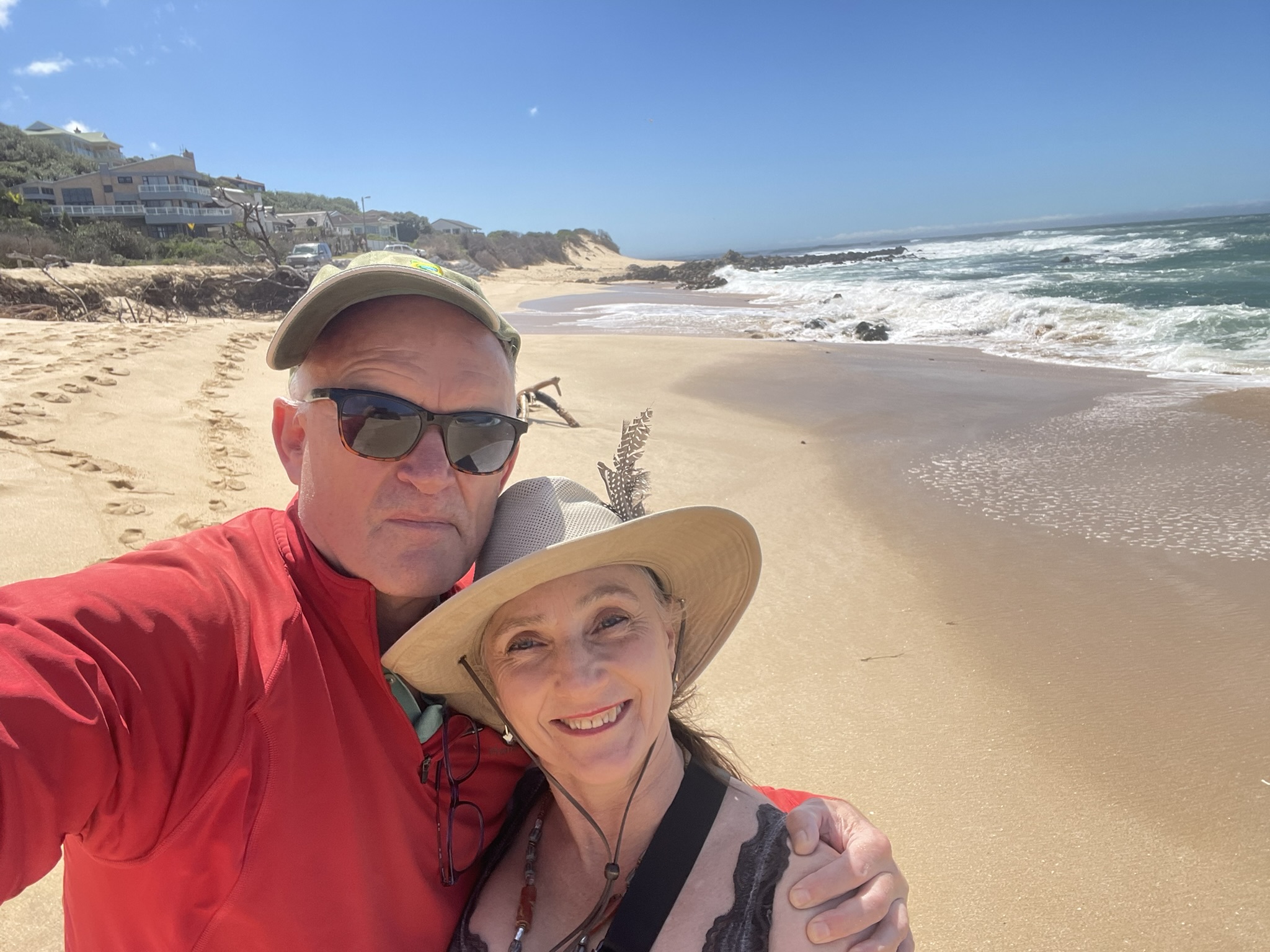
After enjoying the spectacular view of East Beach and the Kowie River, we had supper at Guido’s on the pier while the sun set. My mother gulped her Margarita down in seconds, she loved it, but not the salt on the glass. The following morning, after a plentiful breakfast and a chat with Isabeau, we loaded my mother into the wheelchair again and pushed her along West Beach Drive. We left her sitting in her chair, with a view of the ocean, while we walked along the beach. During our absence she was visited by a concerned healer who wanted to pray for her. We in turn encountered Michael McMurray, the author of “Missy Mey goes to the circus”, his daughter and their lovely Golden Retriever. We had an interesting discussion about the changes in South Africa over the years, the threats to its development and the apathy of the current youth.
Later we traced our steps back along the R72 and onto the N2, finally stopping for the night in Sedgefield. Cleopatra, meaning beloved of the father, greeted us at the Pelican Lodge where we spent a very comfortable night. We ate dinner at the Montecello Restaurant where the snails were, according to my mother, quite delicious. I lightly commented that there was a paucity of wine when I had finished my glass only later to receive a new one from the waiter. The man sitting at the next table had heard my cry and ordered me another glass, starting a long and interesting chat with him and his wife about electric cars and health care. The couple had retired to Sedgefield, having previously lived in Johannesburg. The next morning at the ample breakfast I chatted to Cleopatra. She told me the shocking news that she was going to bury her 4-year-old grandson that weekend. He had been playing on the dunes with other small children and was apparently taken by a large dog, or cat as one of the children said. His mauled, lifeless body was found later some distance further on.
13th November – Betty’s Bay
Retracing the next section of the N2 past George and towards Swellendam was rather tedious with frequent delays and single carriage roads due to the road works. Listening to 1984 provided some distraction. Winston had now read The Book, had been arrested for treason and his neighbour had been reported to the authorities by his own daughter for thought crimes.
My mind wandered back to a piece of graffiti I had seen more than 25 years ago painted on a concrete bridge in Johannesburg –“Play Sonja Herholdt backwards for a potjieskos recipe.”
Suddenly I was 10 or 12 years old again, sitting cross legged in a big hall, somewhere in the Northern Transvaal at a school veld camp. We were listening to a man in a safari suit with a short back and sides haircut, wearing veldschoens and who probably had a comb in his high green socks. He was getting rather excited about the dangers of sex, drugs, rock and roll, communism and the devil. We had to be careful as we were being continually subliminally exposed to propaganda. Did we know what the songs “Lucy in the Sky with Diamonds” and “We all live in a yellow submarine” really were about? If we played the Rolling Stones or the Beatles backwards, we would be shocked at the ungodly things we might hear. The next day, we were woken early, had to dress quickly and stand to attention in rows for the flag raising ceremony. I’m not sure exactly what we did, maybe we just did not show enough enthusiasm, thus committing thought crimes, but our behaviour infuriated the man. He sent us on a 5 km run as punishment for our insubordination, chasing us with a stick to make us run faster. For the rest of the camp week spontaneous bouts of singing, “Why don’t we do it in the road, why don’t we do it in the r-o-a-d ”, and “We all live in a yellow submarine, yellow submarine, yellow submarine”, could be heard at the most unexpected moments.
We left the N2 taking the R44 and made our way to Betty’s Bay to visit an old friend of mine Johan. Johan is an interesting and genuine person who has always followed his heart. He works remotely from home using state of the art electronic equipment while surrounded by nature. He has created his ideal world, his man cave, at his home in Betty’s Bay. He built a lovely wooden cabin with the mountain behind it, overlooking the Bay. All non-indigenous vegetation, such as the rooikrans which was initially introduced to stabilize coastal sands, has been removed from his garden. He has created secret places to sit and meditate amongst the arum lilies, agapanthus flowers and old mans moustache hanging from the trees. He is building a pond, is starting a vegetable patch and has planted proteas on his little hill. He has also left some areas untouched to encourage the mountain bokkies to visit and kept the small wetland where the frogs breed. He puts worms of grated cheese out for the birds. The robins and chats have become quite cheeky, even venturing into his kitchen looking for more. While we were there a mongoose also came to enjoy the feast. Johan has also caught other visitors, such as porcupines and a genet on his webcams.
After sleeping on Johan’s ample couch with the wind blowing and the ocean roaring all night, we went to see the penguins. On the way we passed several “penguin crossings” with penguins painted on the road. Please, don’t call them “Jackass” penguins, their new name is “African Penguin”. The bay with its rocks where they live is quite beautiful. The big fluffy grey babies were constantly fluffing out their feathers and demanding attention from the adults. A large family of dassies was basking in the sun.
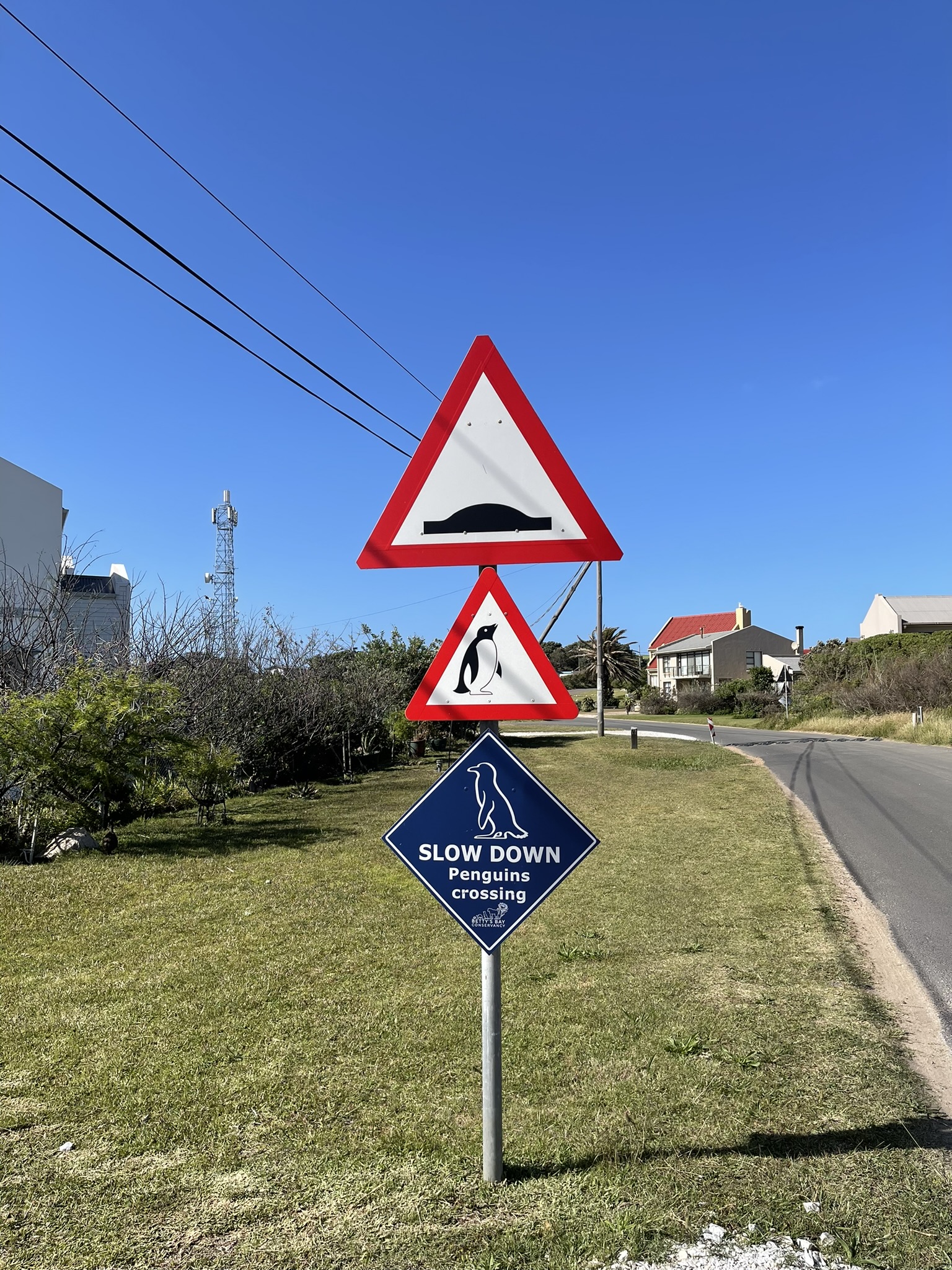
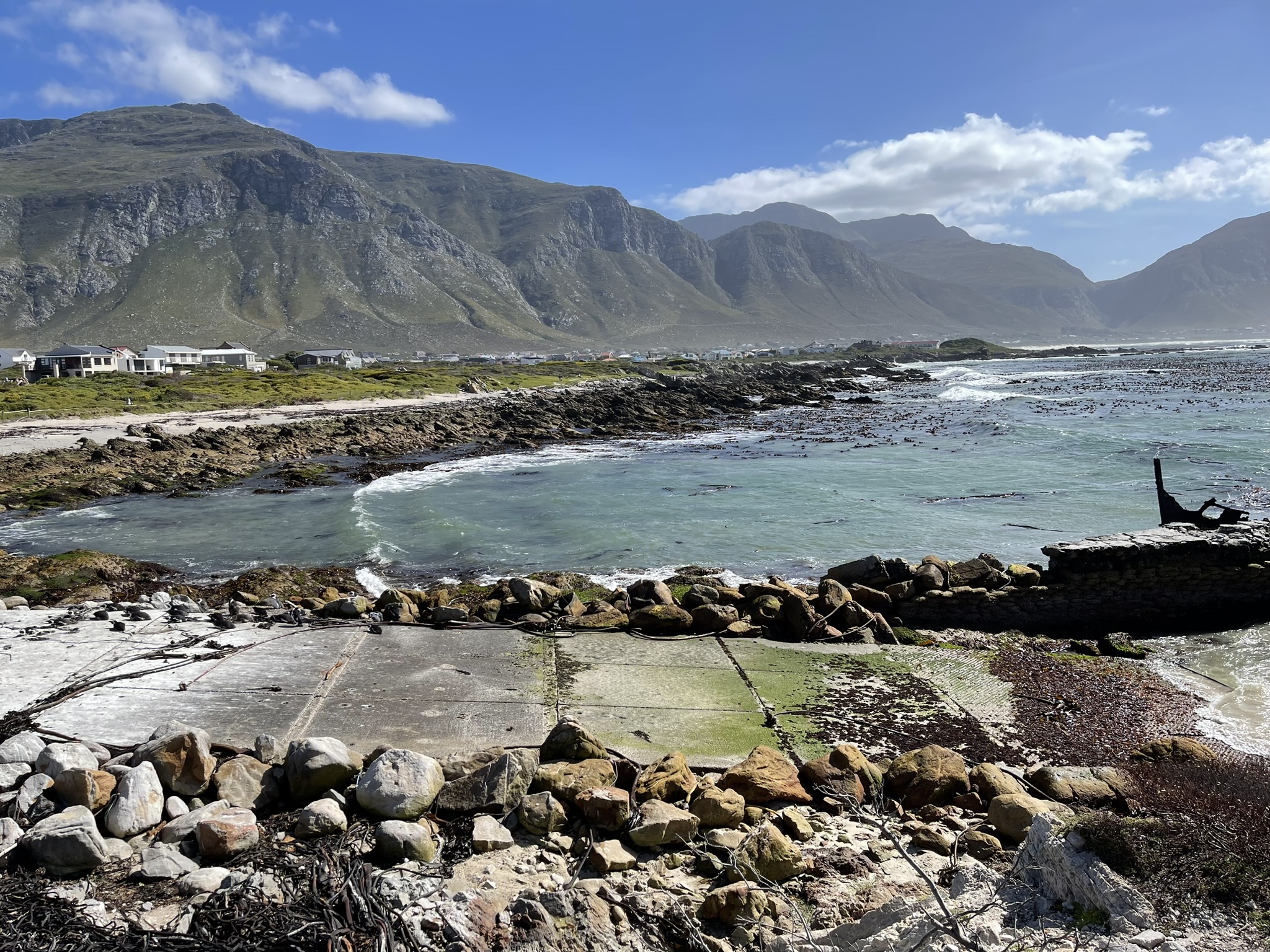

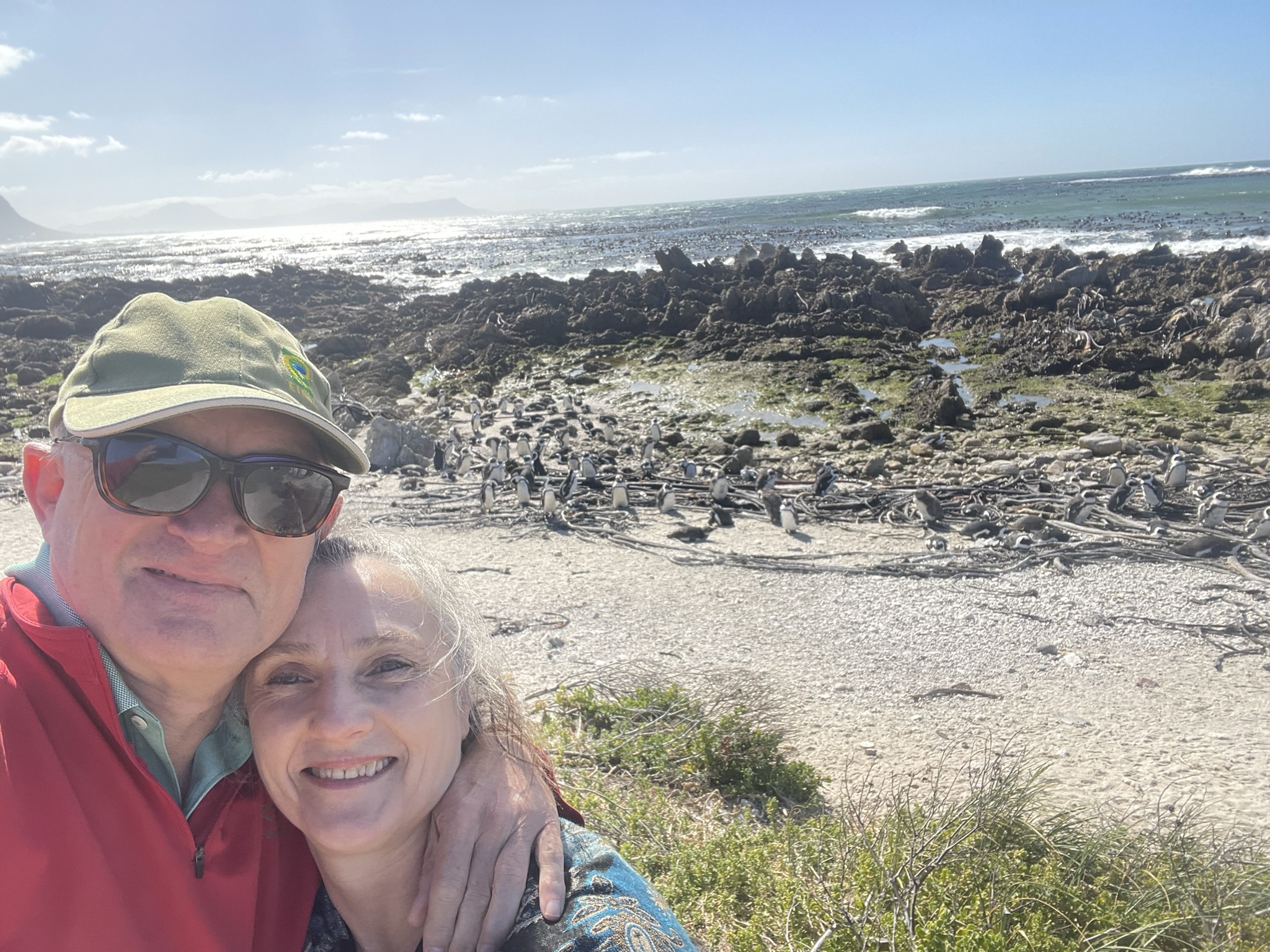
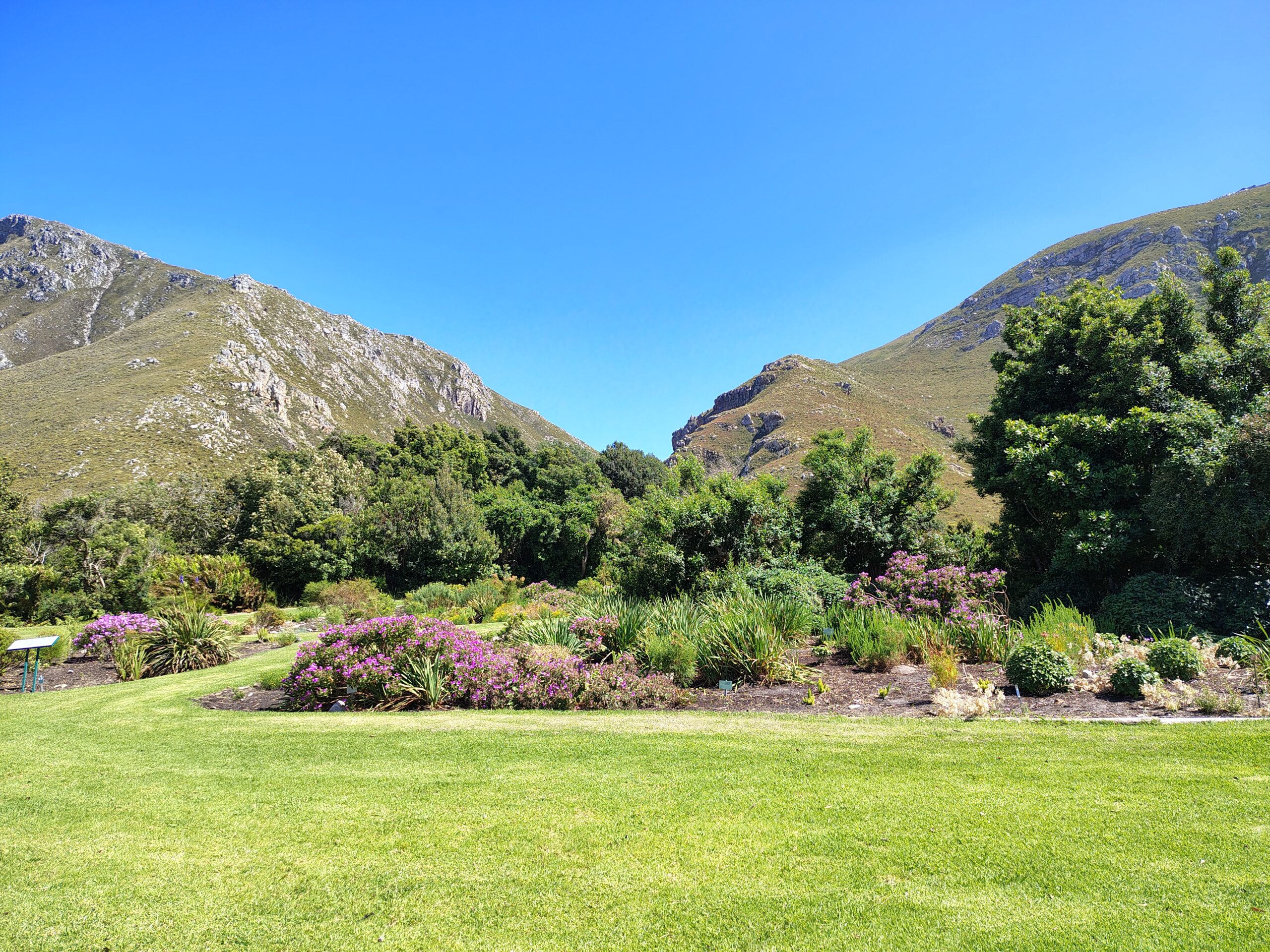
Our last stop before setting off along the scenic R44 following the coast back to Cape Town was the Harold Porter Botanical Garden. Here we could take my mother around in the wheelchair again allowing her to also enjoy the natural beauty of the plants and location. We wandered through the coastal fynbos, crossed the bridges over a creek with copper-red water trickling over rocks and looked down over the bay and ocean. I found the medicinal plants and the house-keeping Koisan style sections fascinating. I thought we should be planting more Spekboom to help against global warming and learnt that the moon was created from the debris resulting from the collision of a Mars-sized body with the Earth 4.5 billion years ago. It was a health awareness day, and the employees were joyfully singing and dancing on the grass.
Back at my sister Belinda’s house in Cape Town I was contemplating my trip while swimming in her warm pool. I was in quiet seclusion with the sun glistening through the trees. Squirrels were rustling the leaves in the hedge. A hadada came to drink water, quite unperturbed by my presence. He seemed less prehistoric looking than the hadada’s that visit my brother in Johannesburg, his bill, less curved. I thought about the diversity of South Africa, its problems and potential, and then about the world in general. We all have a story to tell and can all contribute if united and not dominated. The Coelacanth has many fins which it expertly uses to manoeuvre in deep water. By using all its special attributes, its fatty lung and electronic navigation system, and coordinating its limbs, it was able to keep its uniqueness and evade extinction.
I got out of the water leaving wet, black footsteps on the slate surrounding the pool. “Oh, my God, Sally, what did you do to your toe?”, my sister asked concernedly some time later, “It looks horrendous”. “I stubbed it on a hot tarmac,” I replied. “That’s what you get from Skinny Footing in Africa. Don’t worry, it already looks much better. It will heal, but I might be left with a small scar.”
